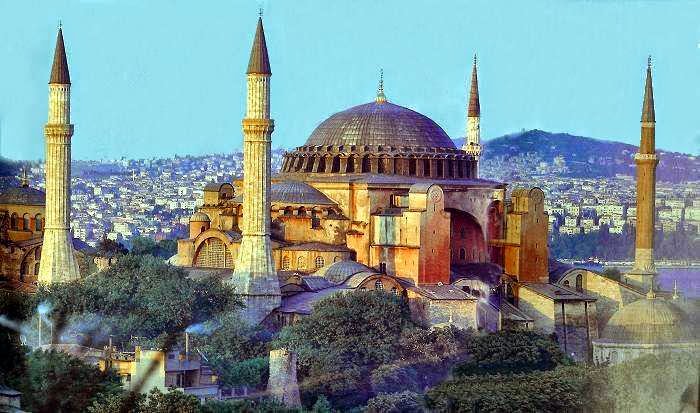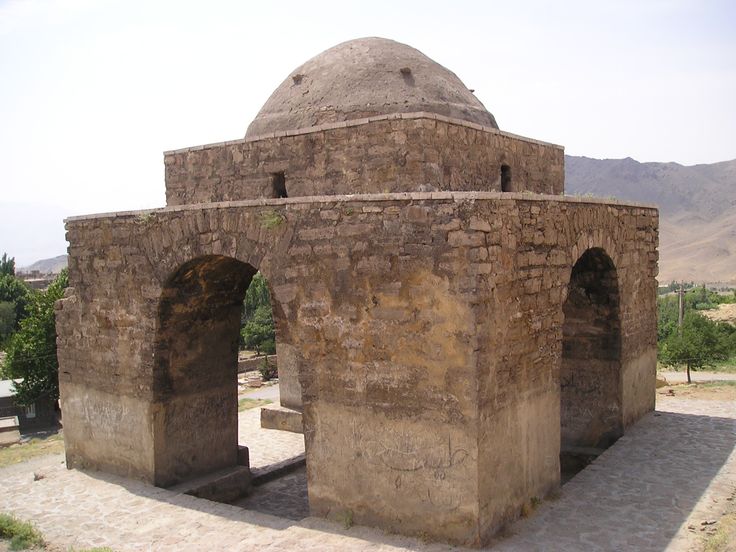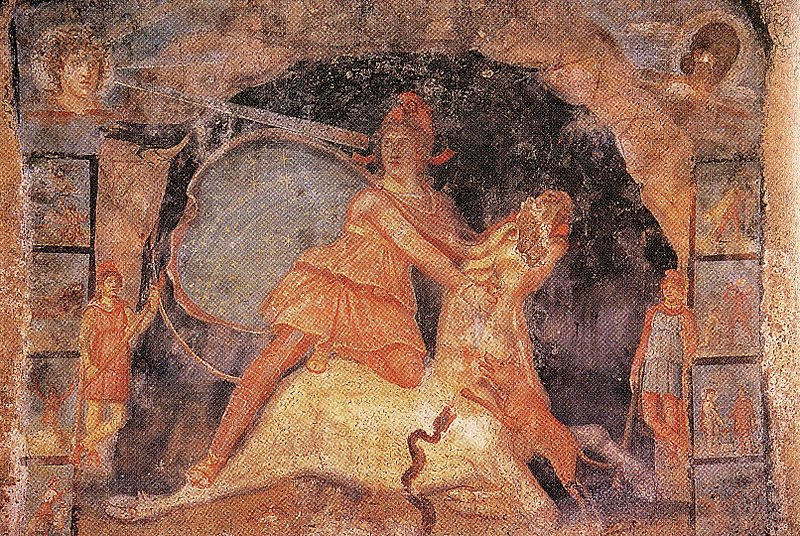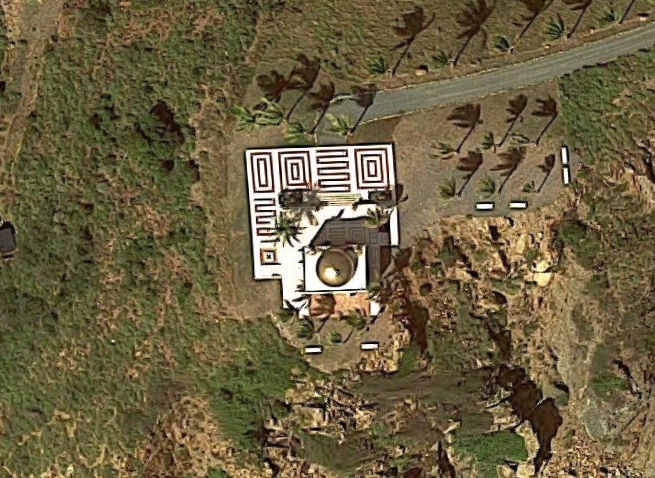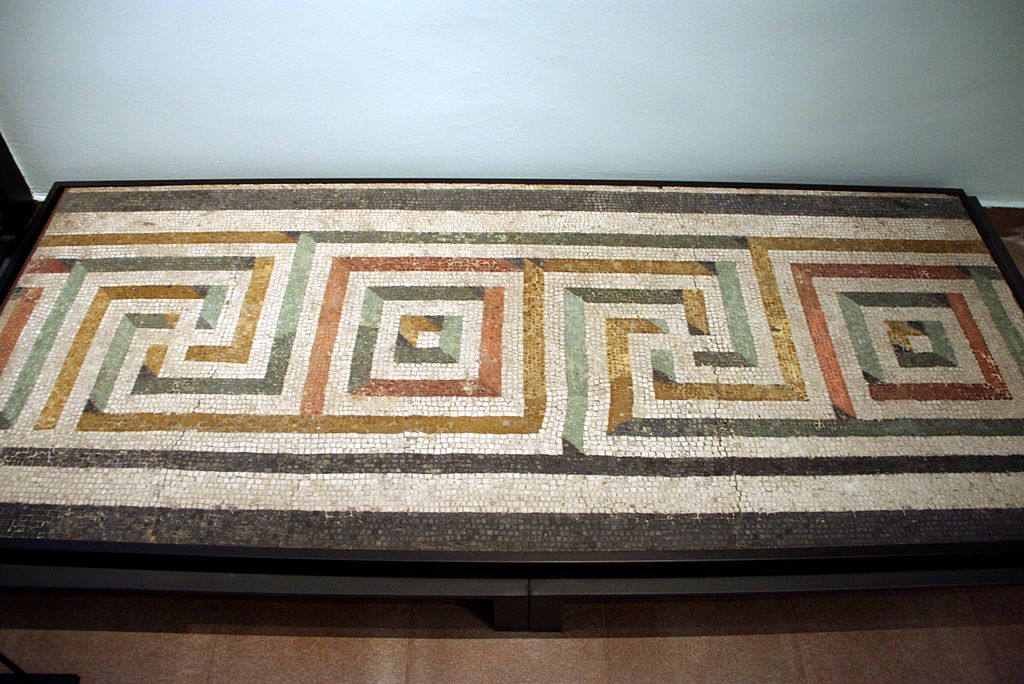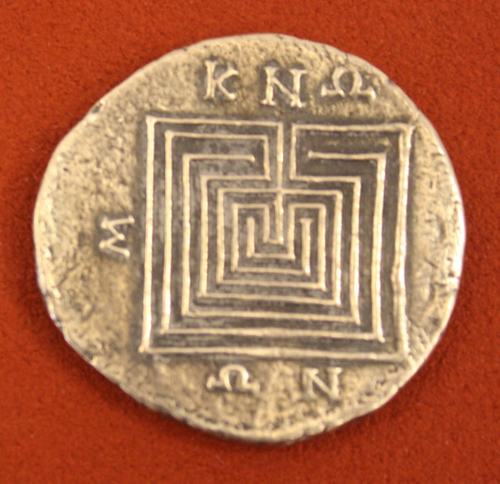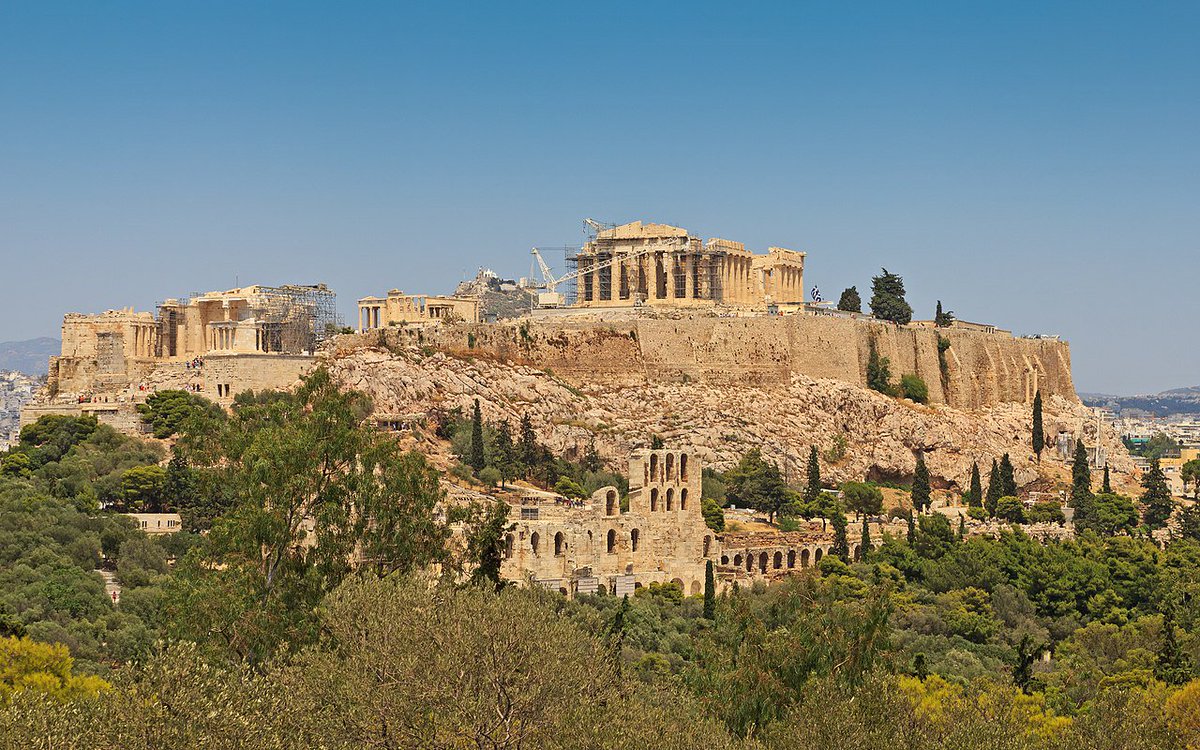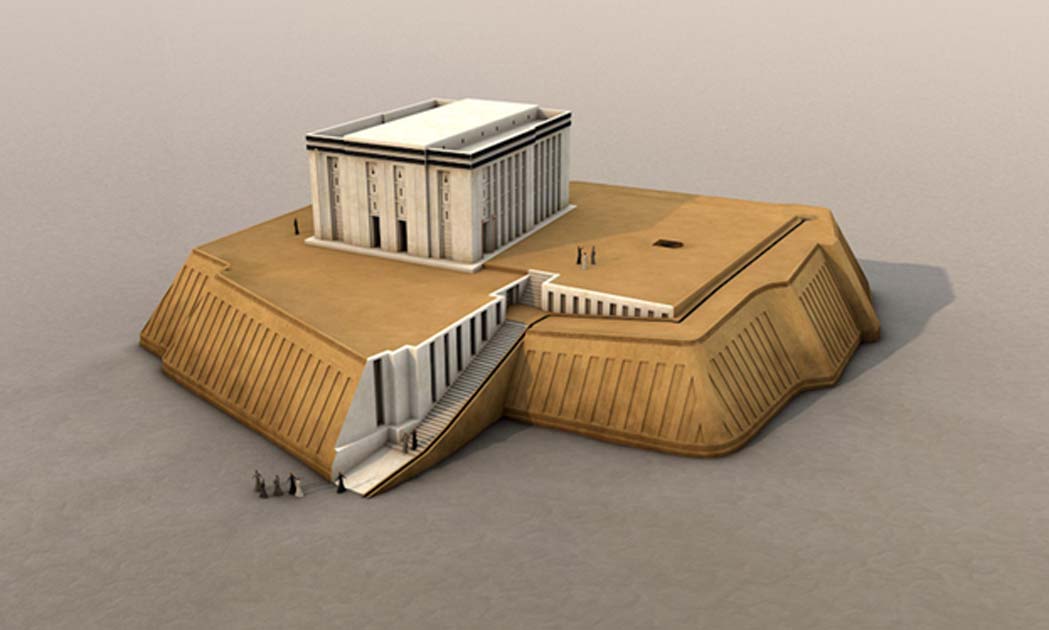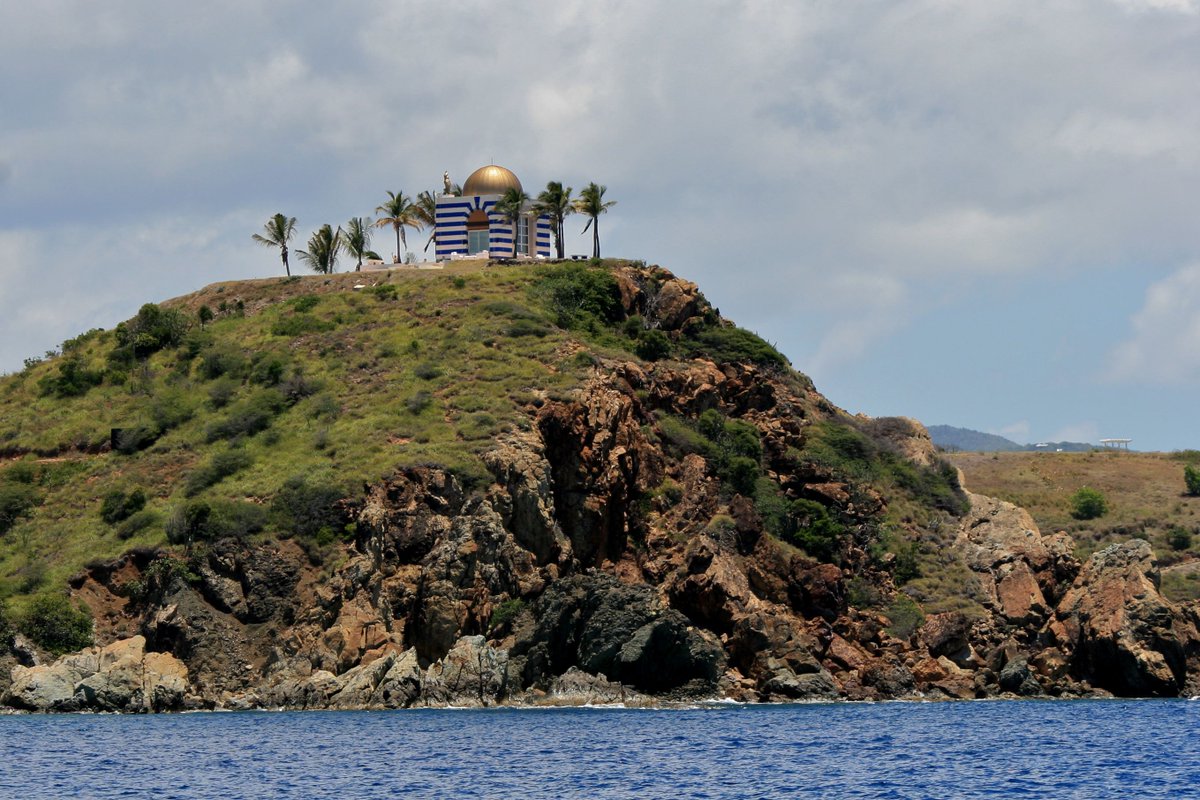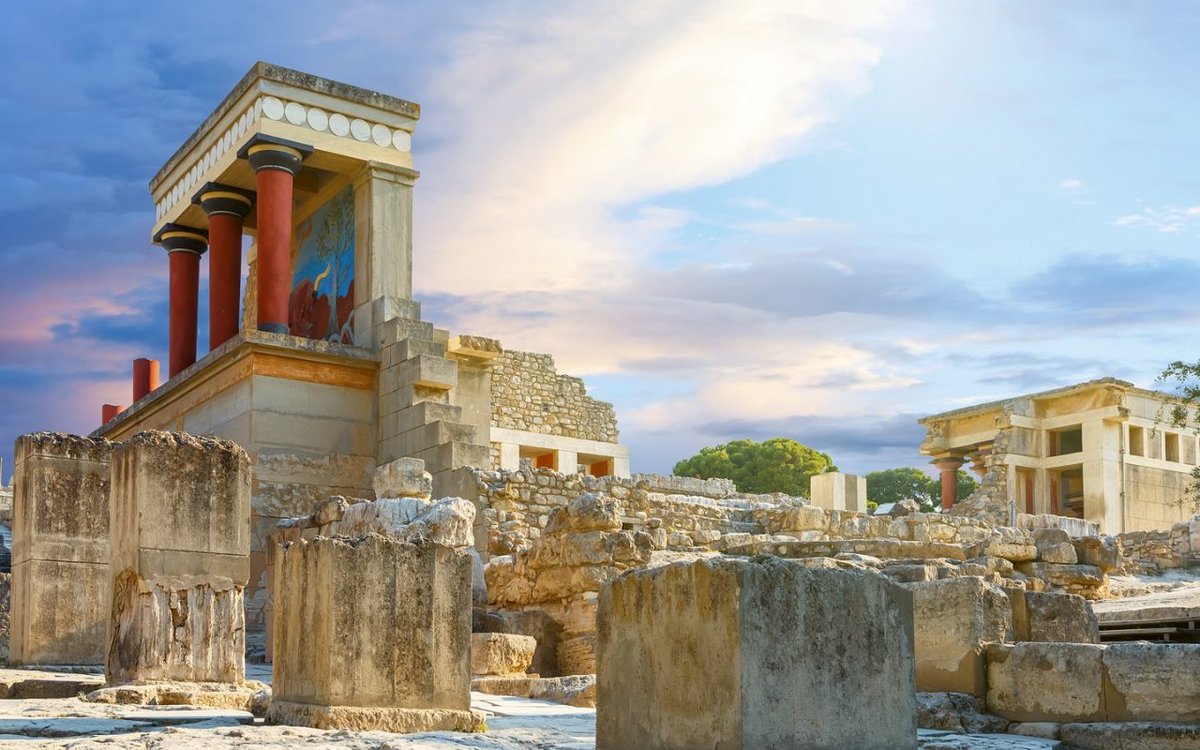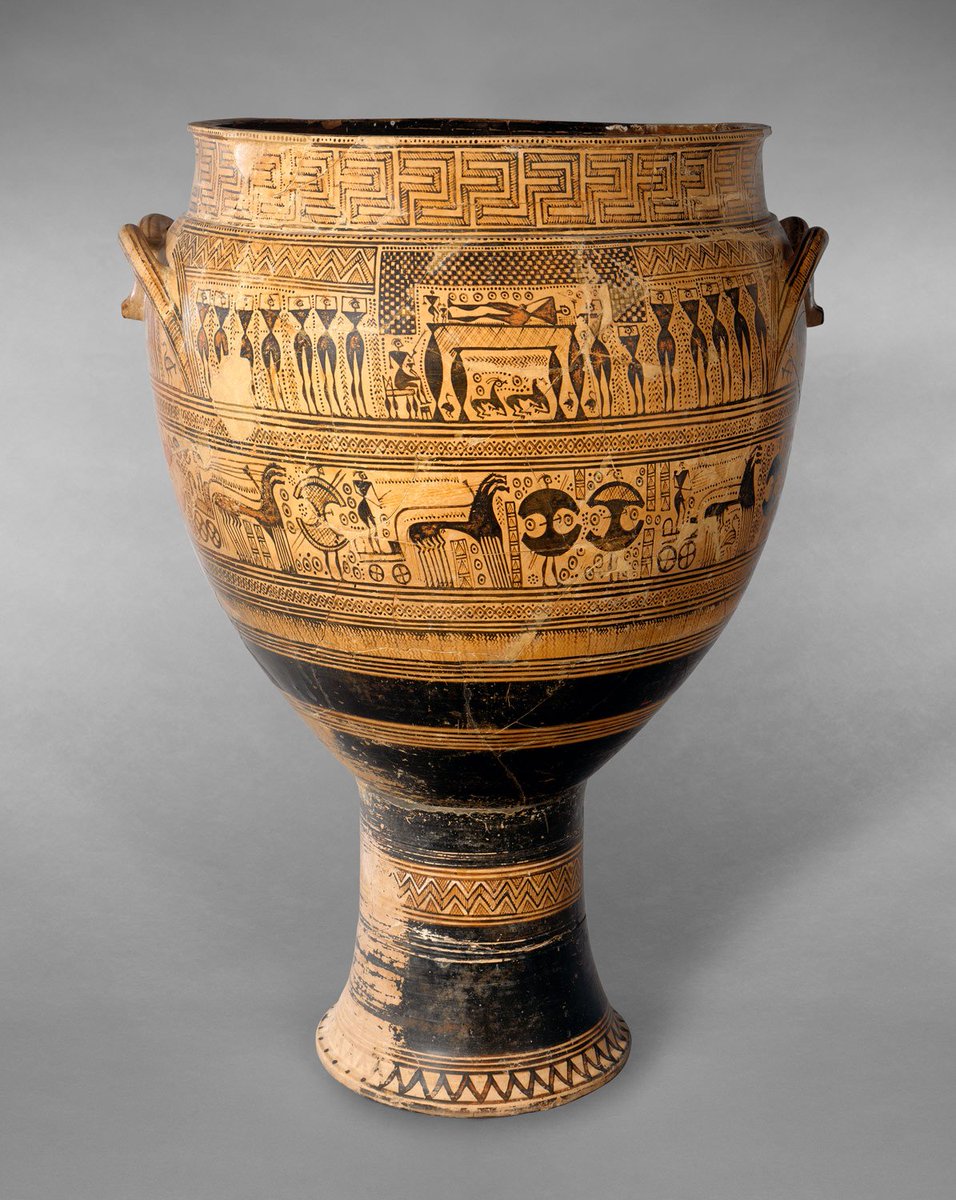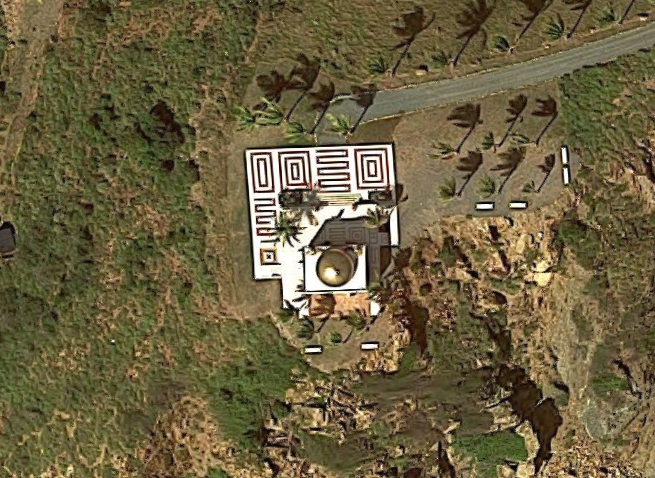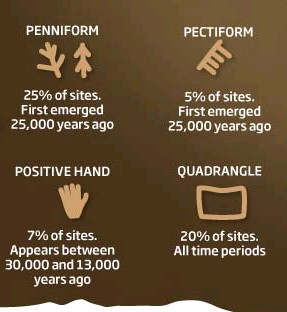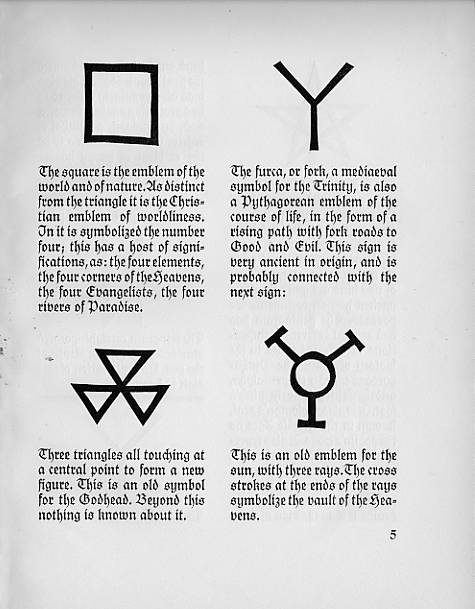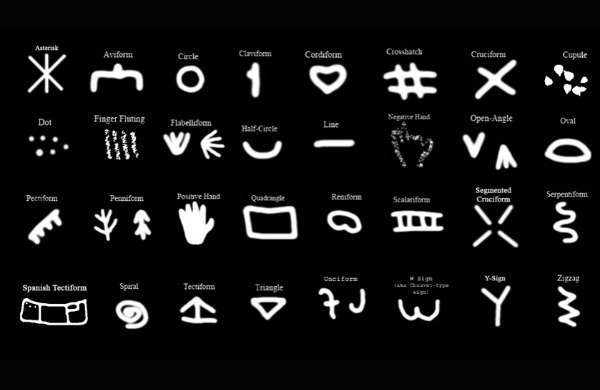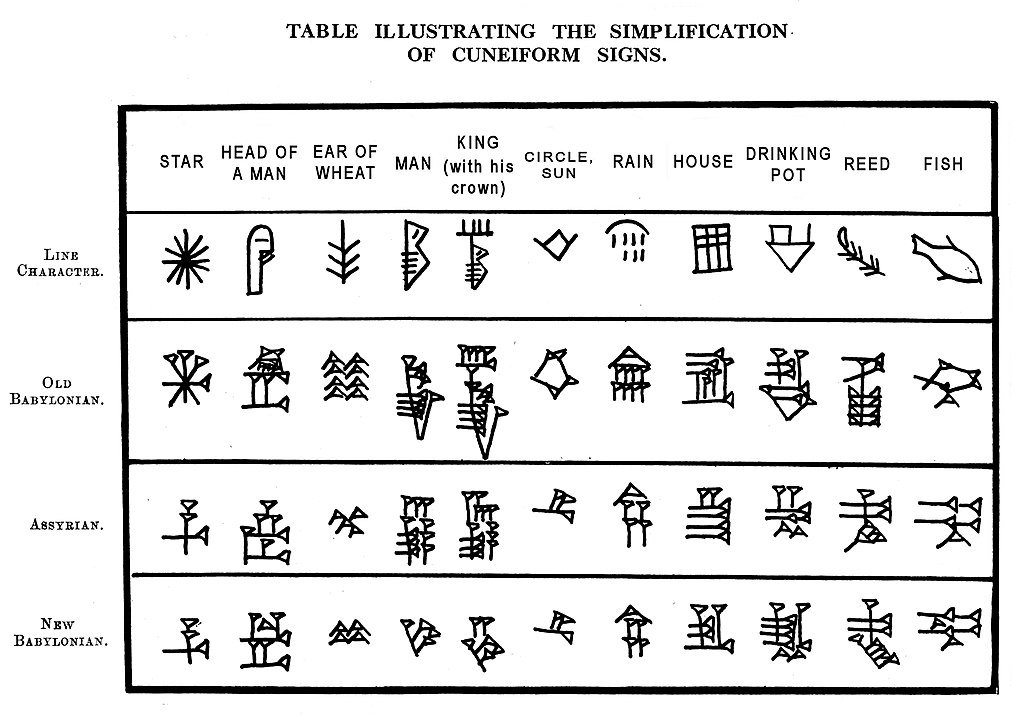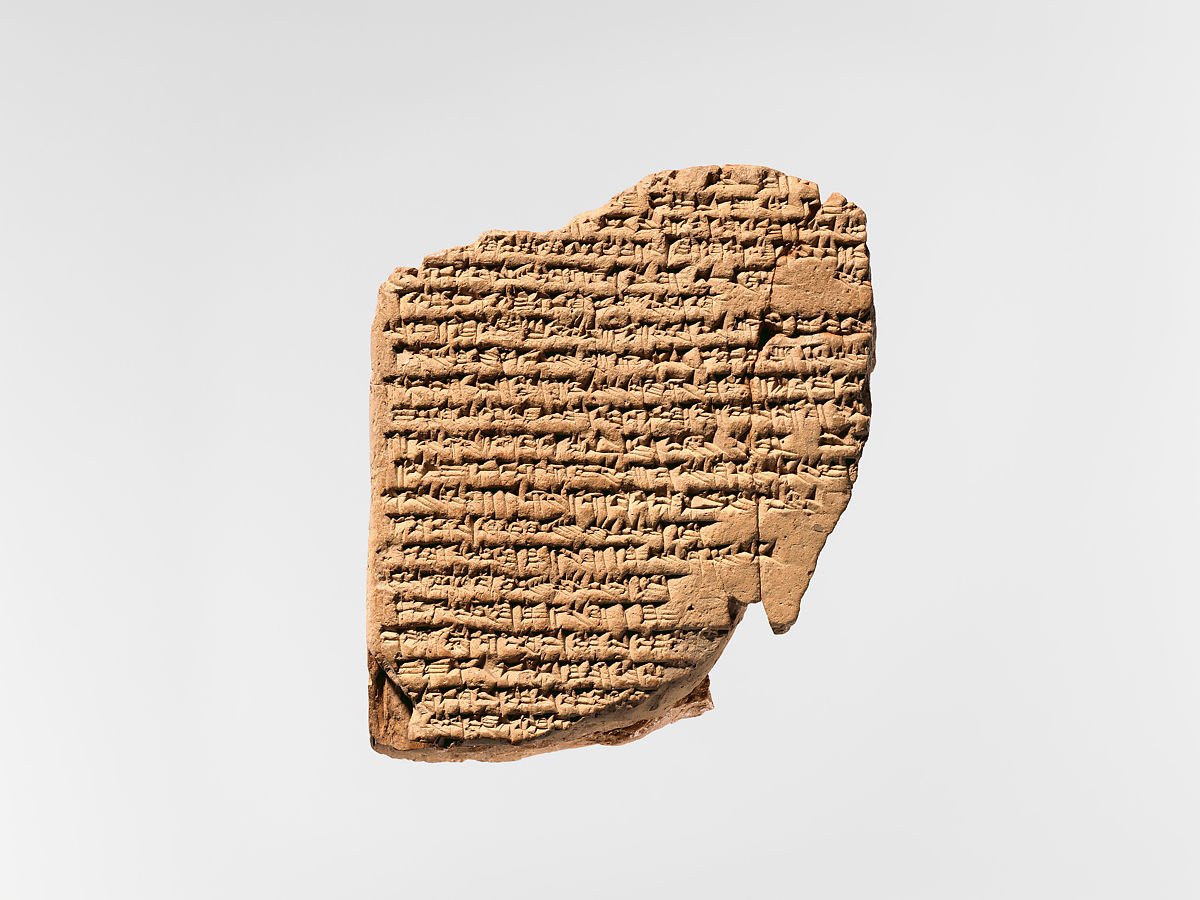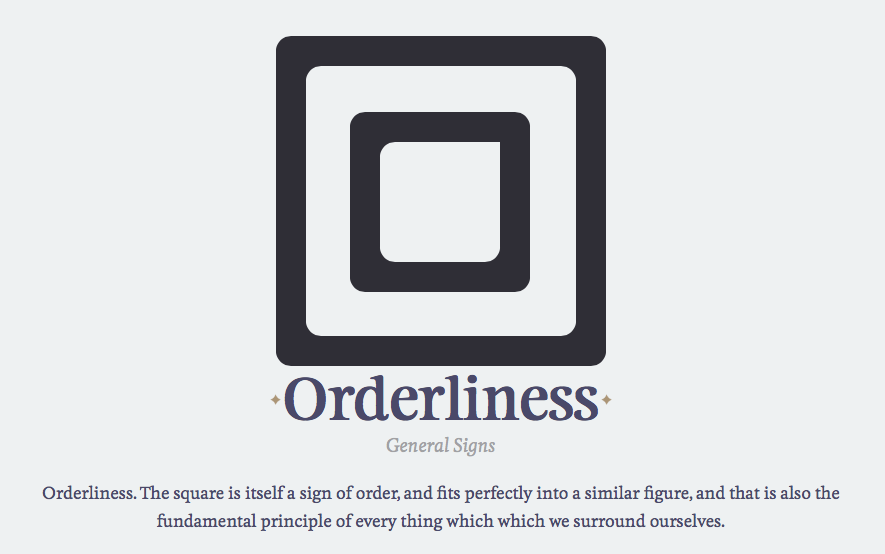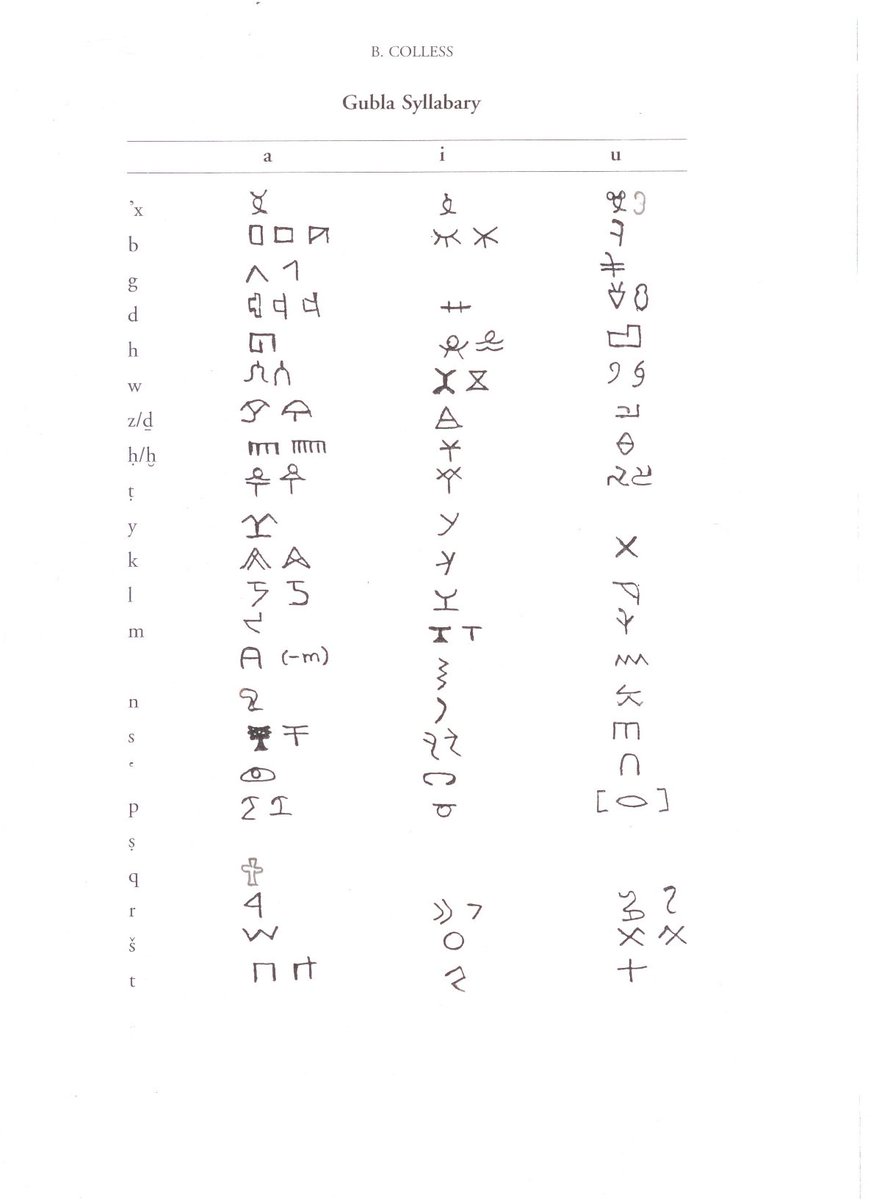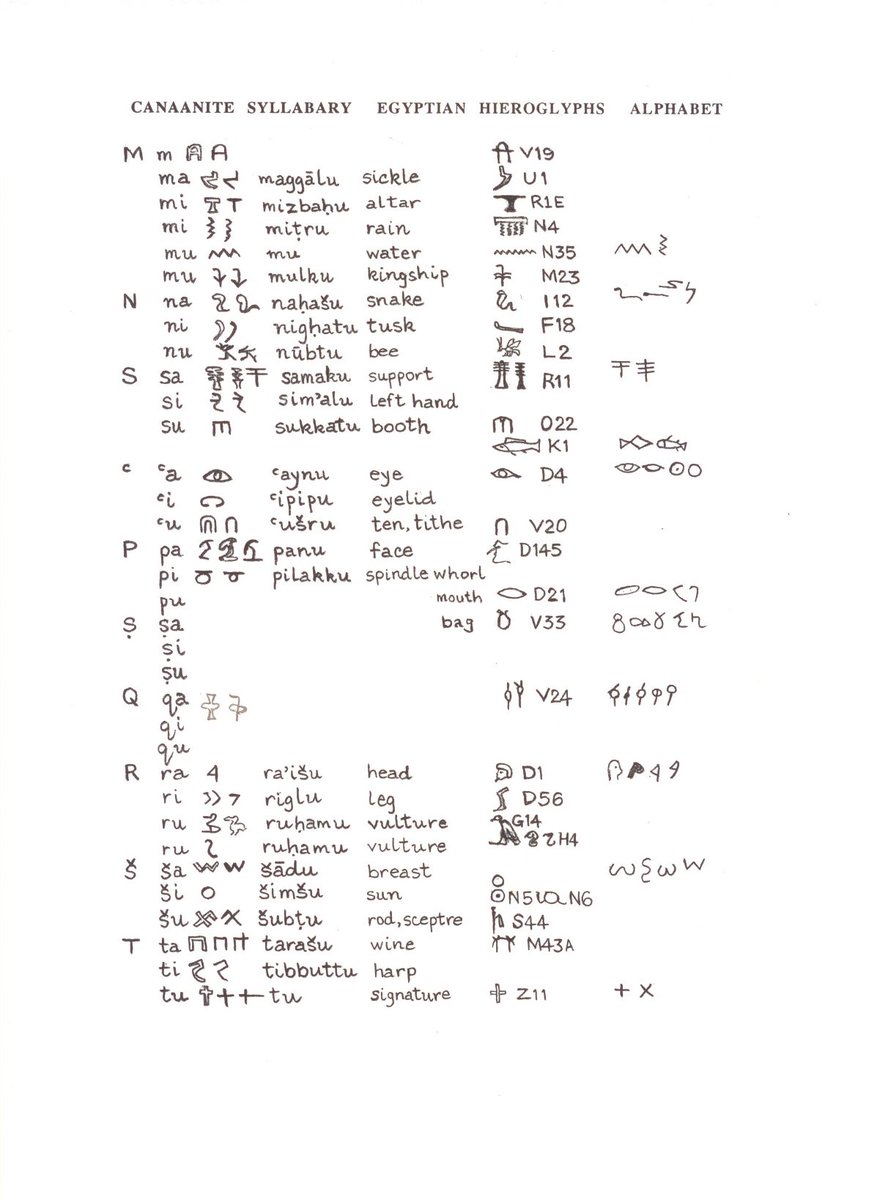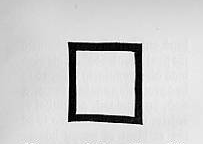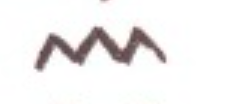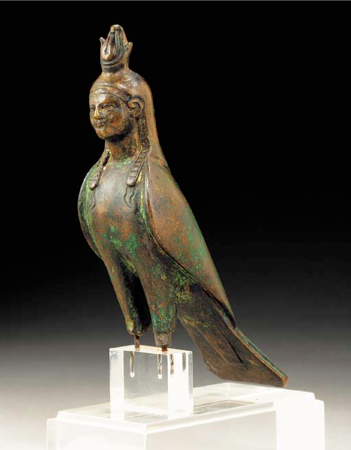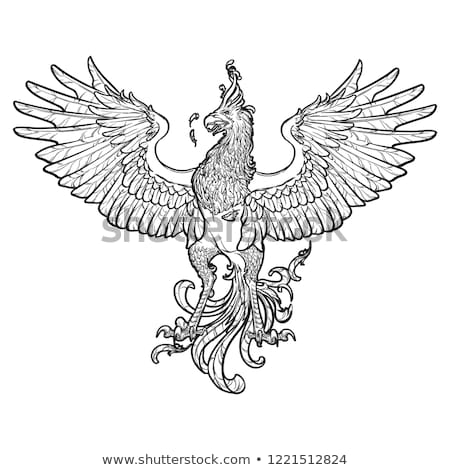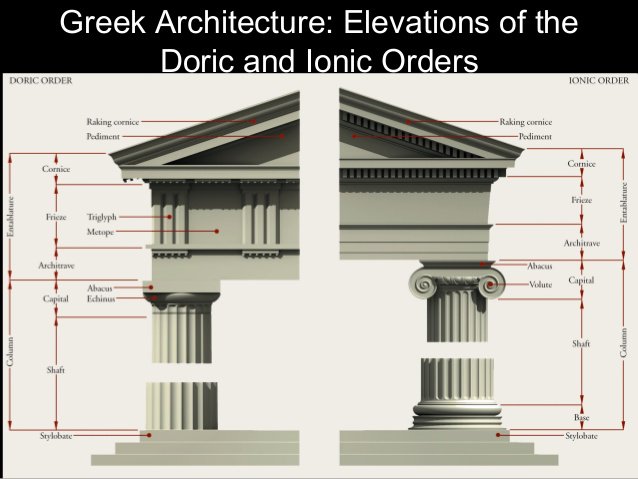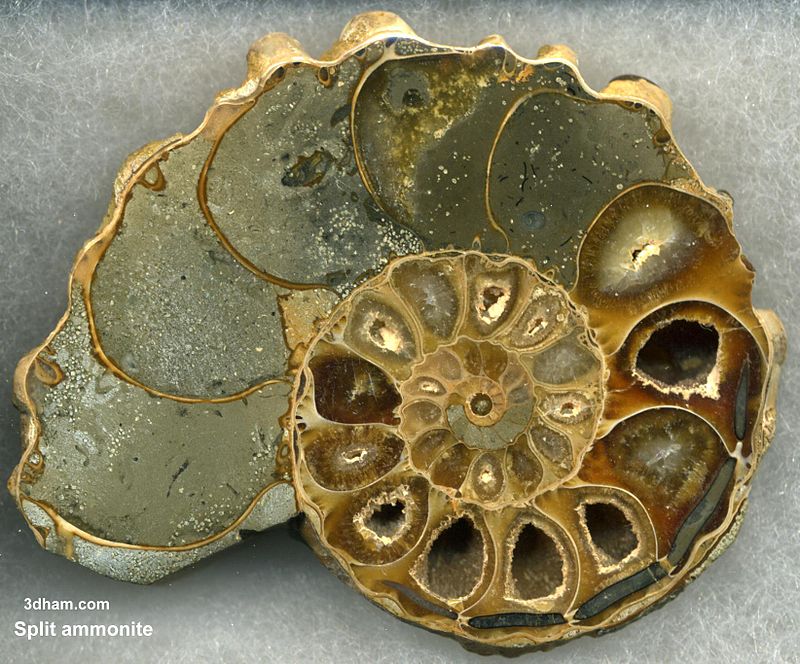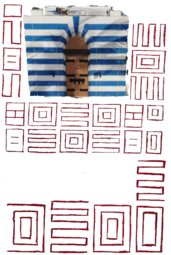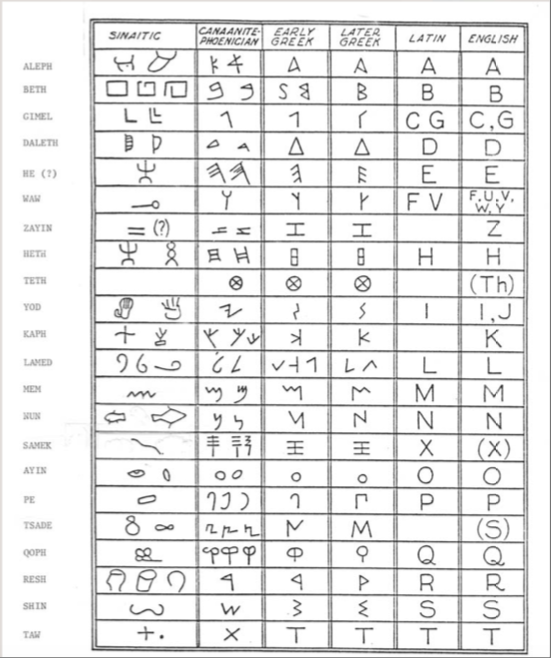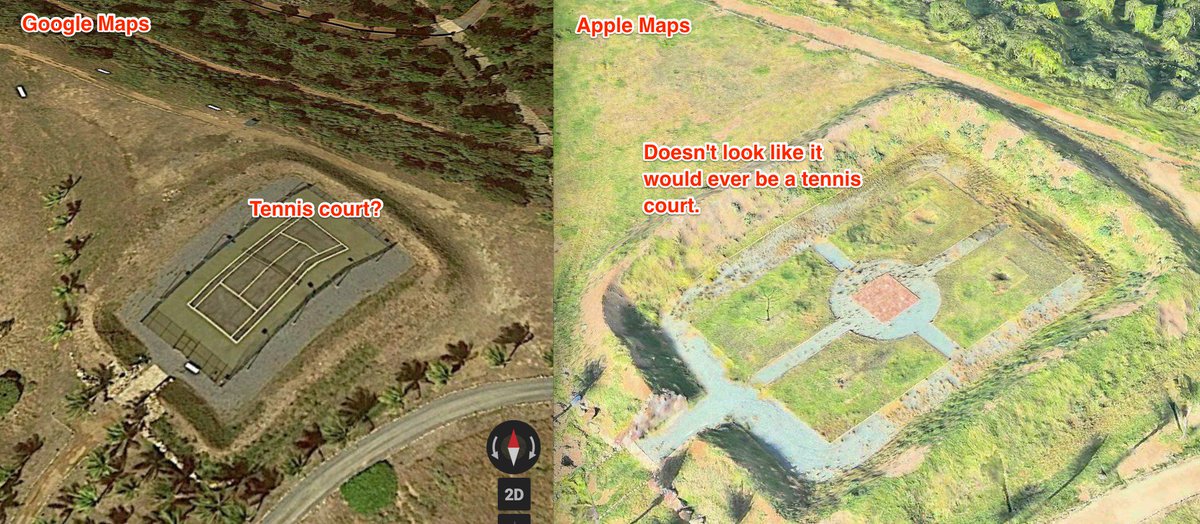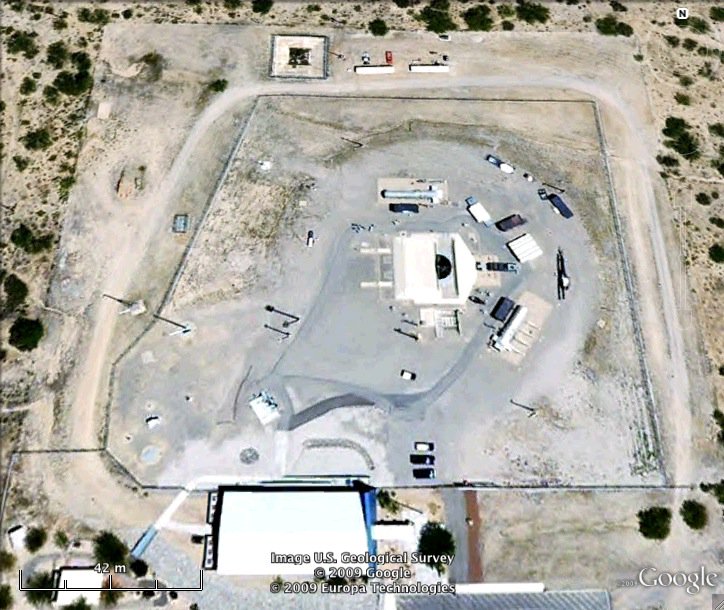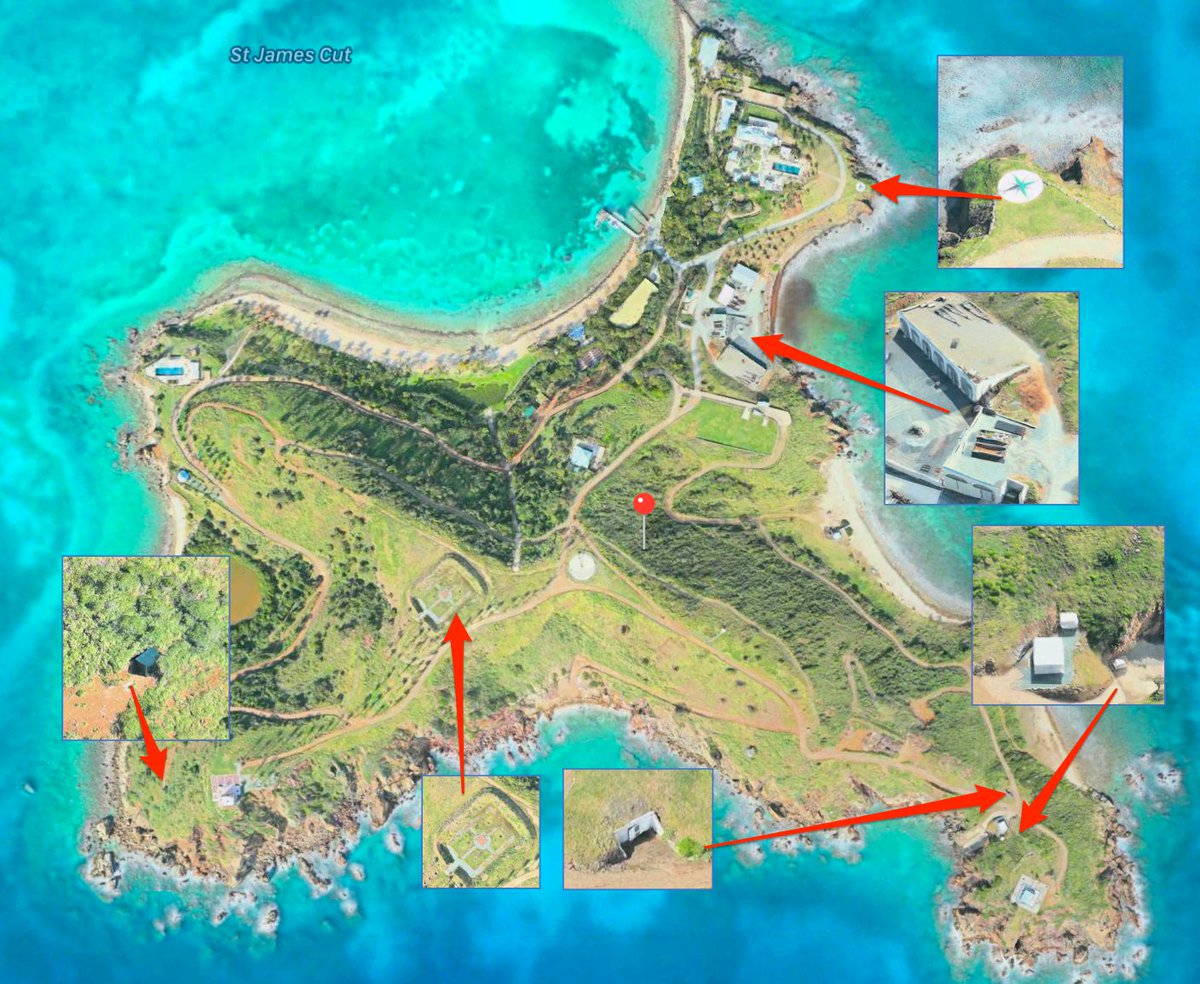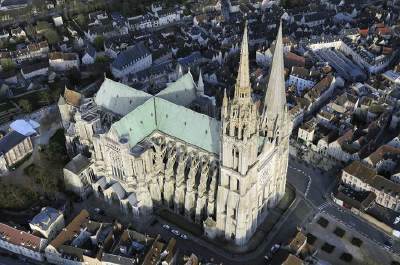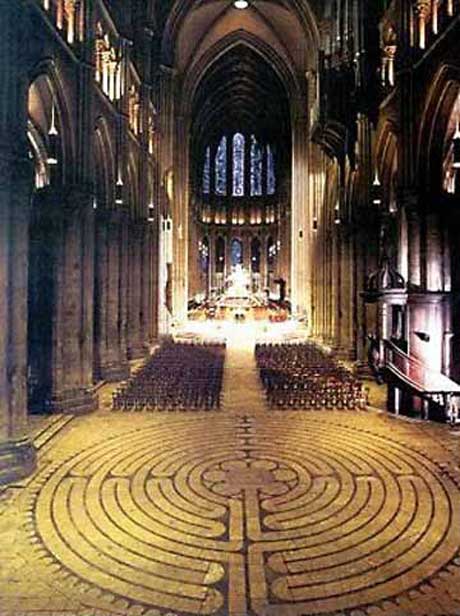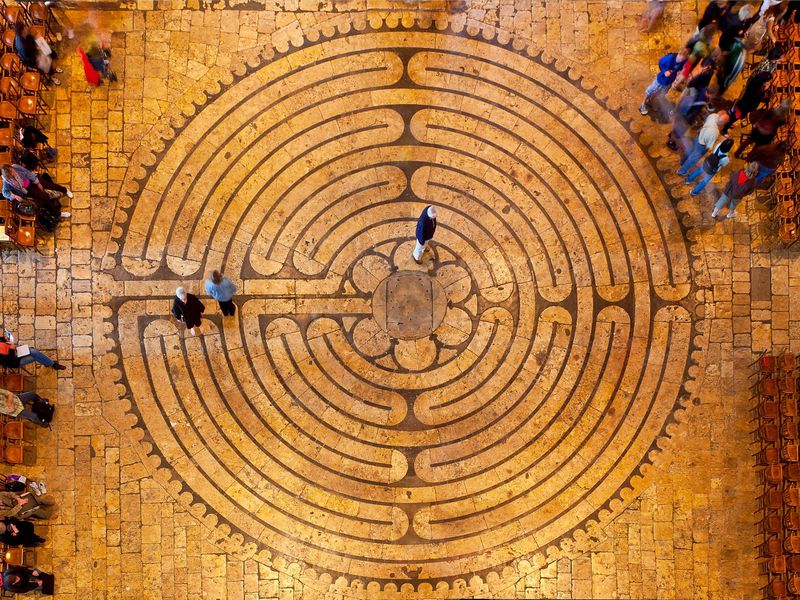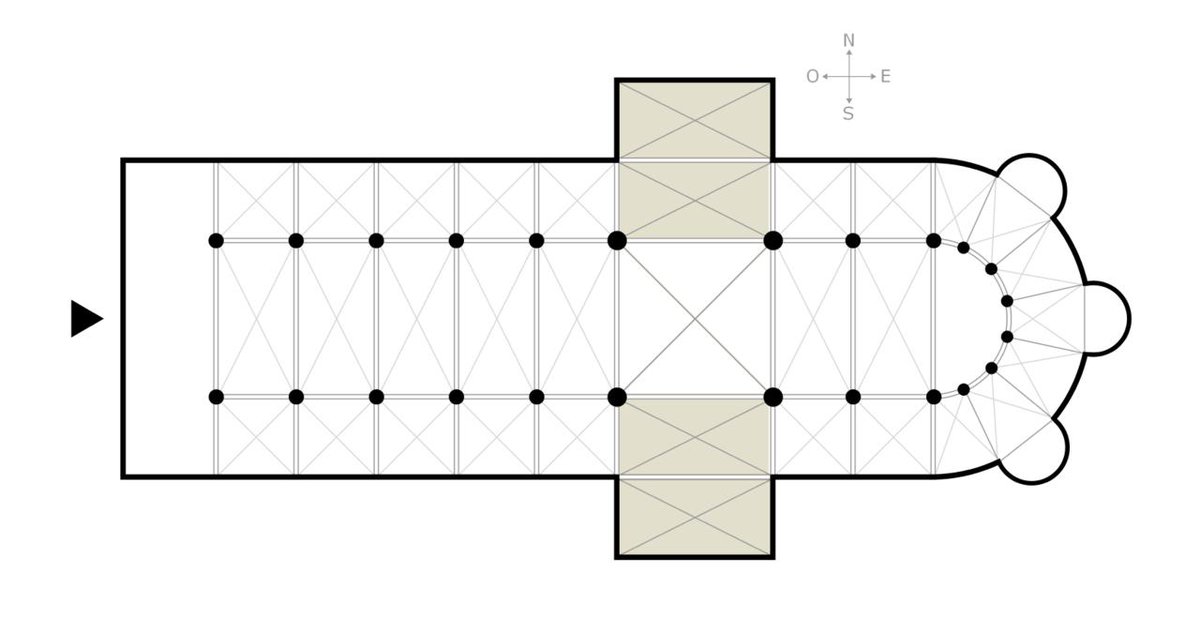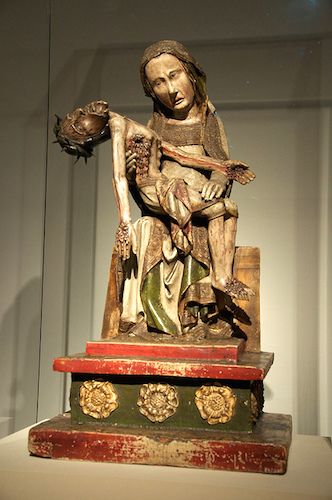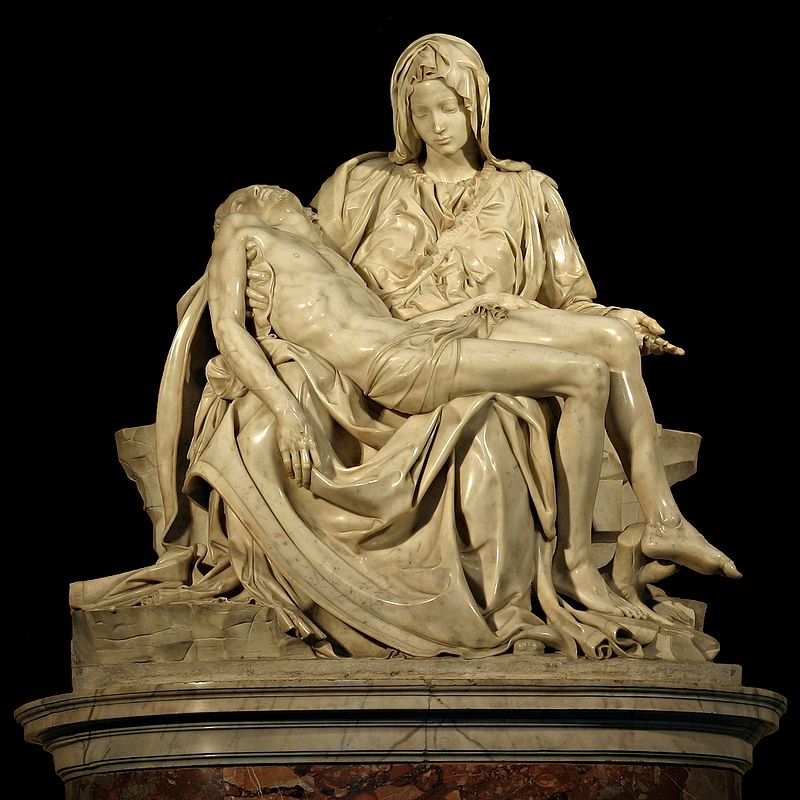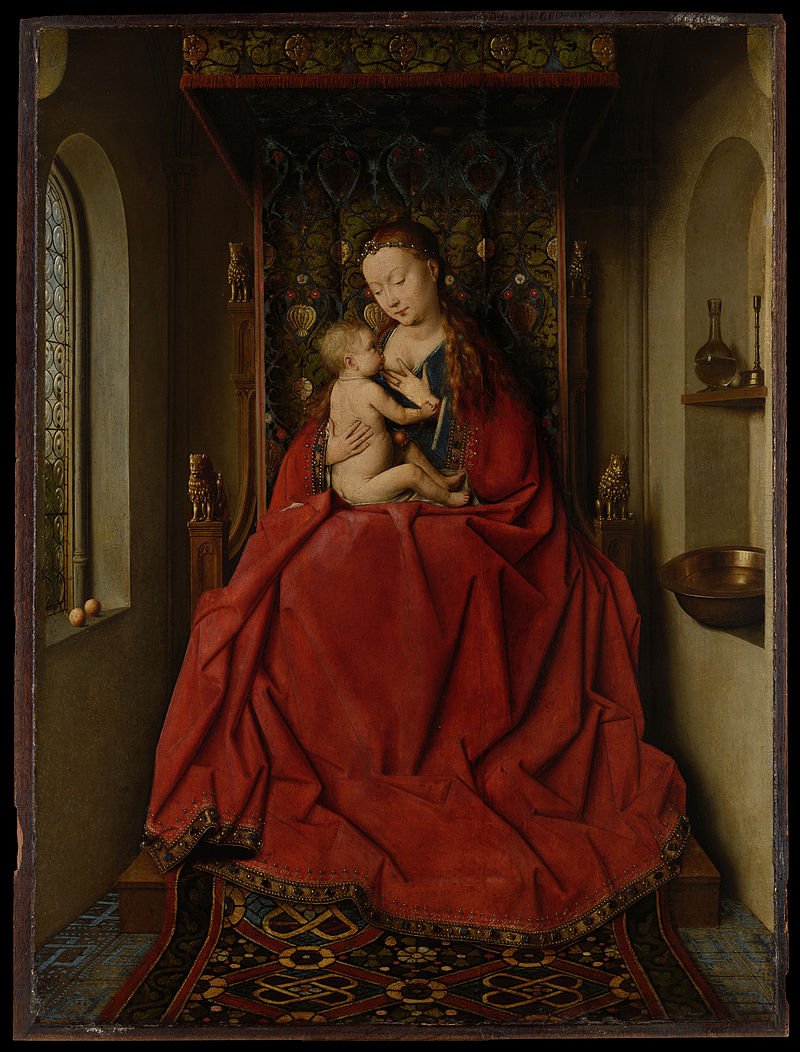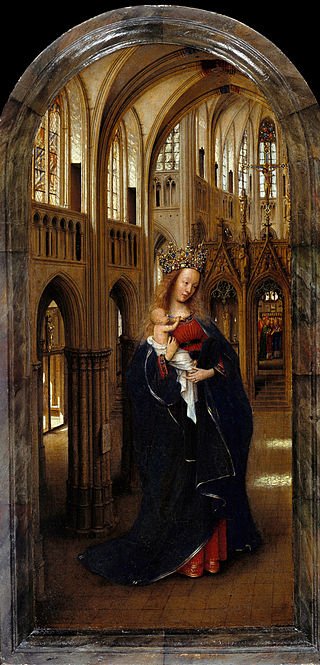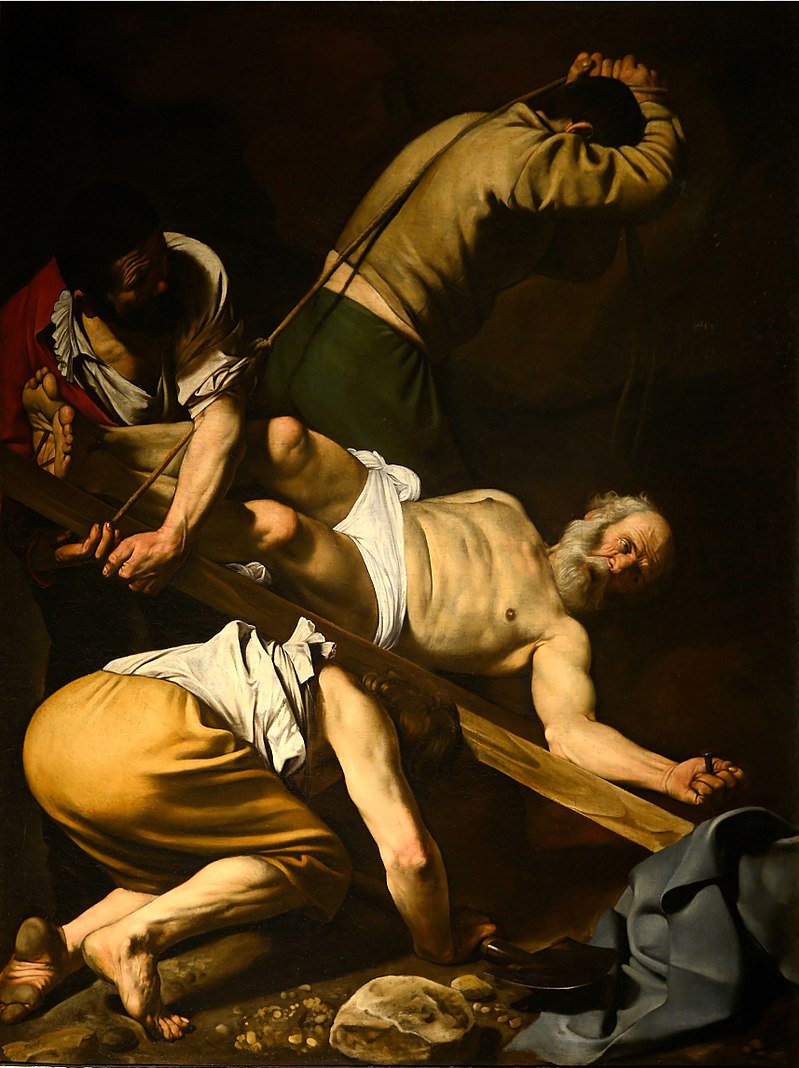I have been extremely confounded by this horrid building, for reasons that are probably obvious to anybody reading this. The thing I wanted to understand is why it looks the way it does. Maybe someone else has already figured this out. But here goes nothing.
I found this picture online tonight. It is the "[e]xterior of entrance portal" to Khan al-Wazir in Aleppo, Syria. Looks familiar, right? https://archnet.org/sites/2865/media_contents/75544
This structure is called a "caravanserai", which means that it's basically a stop for a traveling caravan. https://archnet.org/sites/2865
The stripes on Khan Al-Wassir are due to "ablaq" masonry, where the color of rows of stones is alternated from a darker to lighter color. It's pretty common in the muslim world and can be found on the interior and exterior of a lot of mosques and other buildings.
The ablaq technique itself is a derivative of Byzantine architecture, though there doesn't seem to be an abundance of images online of Byzantine structures that obviously showcase ablaq. Here is one of the most famous Byzantine structures, however, situated in the muslim world.
As you may know, the Hagia Sophia began her life as a Christian church, then was transitioned into a mosque, and is now a museum. It's particularly notable for it's dome, which leads us back to the structure on Epstein Island. Many have wondered about the dome.
Most believe that domes come from about the time of the Roman empire, and were fully perfected in the Renaissance. But actually domes have been around since at least Mesopotamian times.
Here's an example of an ancient domed structure that might also rings bells in your head when you see it. Look's very similar to Epstein's temple, right?
This structure comes from Zoroastrianism, and is called a "fire temple". They exist in both the Zoroastrian and ancient Persian cultures. Their purpose is for cleansing rituals and they somehow seem connected to mithraism, which is a worship of the Zoroastrian deity Mithra.
I know this thread might be tedious to read, but it's even more tedious for me to put together.  I'm trying to connect a bunch of different images and architecture and symbols from many ancient cultures worldwide. Both assembling and solving a puzzle. So please bear with me.
I'm trying to connect a bunch of different images and architecture and symbols from many ancient cultures worldwide. Both assembling and solving a puzzle. So please bear with me.
 I'm trying to connect a bunch of different images and architecture and symbols from many ancient cultures worldwide. Both assembling and solving a puzzle. So please bear with me.
I'm trying to connect a bunch of different images and architecture and symbols from many ancient cultures worldwide. Both assembling and solving a puzzle. So please bear with me.
Now, back to Mithra. Mithra is the Zoroastrian god of contracts, and the keeper of truths. The cult of Mithra was popular in ancient Rome for a while, right before Christianity became more prominent.
Knowing what we know about secret societies, and how highly they place importance of secret oaths, a veneration of Mithra by them wouldn't seem so far fetched.
Mithraism includes degrees of initiation, as well as ritual enactments, as does Masonry. Included in every Mithraian place of worship is an image or statue of Mithra sacrificing a bull, aka a "tauroctony". This part of Mithra's story takes place in a cavern.
Immediately obvious similarities to this story are the stories of Theseus and the Minotaur in the labyrinth, and maybe even Abraham and Isaac in the Old Testament.
Another structure similar to both Epstein's temple and the Zoroastrian fire temple is the Dome of the Rock in Jerusalem. A structure deeply sacred to muslims, the foundation rock is said to be the birthplace of Adam, and the spot where Abraham was to sacrifice Isaac.
The reason why Abraham is important is because all three of the major modern religions (Judaism, Christianity, and Islam) are referred to as "Abrahamic" religions. Though Islam is thought to have started with Muhammed, some believe that it extends back to Abraham himself.
Abraham is a descendent of Shem, one of Noah's sons. There is also the belief that the Old Testament also serves as a genealogy of earthly kings, where the names of these kings are changed for reasons I don't know.
These descendants of Noah, and others, might very well be Mesopotamian and/or Egyptian kings. This might explain a lot regarding architecture in the Western world.
They look weird, and seem to be almost totally unexplainable. I thought about it, and couldn't think of anything similar to them in form. I'm not a technical person or a scientist, but at first I thought they might be some kind of electronic signals, or a formula for something.
And then it dawned on me. They might be some kind of bastardized meander patterns
This meander pattern is apparently significant as far referencing the Maeander River in ancient Asia Minor/modern day Turkey. But it also could be a reference to the Minoan labyrinth.
Which brings me back to the hero Theseus and the labyrinth. But before that here's some images of two pretty well known ancient temples.
Second, a picture of a reconstruction (computer image) of the White Temple at Uruk (modern day Warka in Iraq).
Can you see the similarities between these two temples and you-know-who's temple, at least as far as the manner in which they're situated?
The White Temple in the picture is the box-like structure sitting on top of a sloped platform. The platform itself is called a "ziggurat", and the White Temple is also known as the "Waiting Room" in ancient Sumerian religion.
I see a striking similarity between Epstein's temple, which sits upon an elevated mound or hill, and this White Temple/ziggurat combo.
In the ancient world (I'm concentrating on Mesopotamia and ancient Greece right now) temples were build on either platform constructions, like the ziggurat, or a naturally elevated area was chosen, such as for the Acropolis in Greece, "Acropolis" meaning "high city".
I kind of want to concentrate on ancient Greece is the meander pattern, but also because that pattern leads into the labyrinth. I haven't seen anything similar to the meander pattern, but I could be wrong. These are my observations, but I'm not an encyclopedia. Just a nerd. 

The thing to know about ancient Greece, and it's art/architecture, is that Greece is heavily influenced by both ancient Egypt and Mesopotamia. The Orientalizing period in ancient Greek art means the orient/east in regard to Mesopotamia.
There is also the Geometric period, where we get the meander pattern, and the Archaic period respectively. These come before the Orientalizing period and are influenced by art created in the cultures on the islands in the Aegean sea.
In order to talk about the meander pattern, I also have to talk about the Minoan culture. But first I also have to go back to Mesopotamia (Sumer). With regard to the labyrinth I want to talk about the possible connections to Moloch.
But in order to do this I also need to talk about the Sumerian story of the Underworld. They're very similar and the reason why I'm writing to you regarding all of this and it's possible connection to the Epstein Island temple's design/meaning. See how complicated this gets?
Going back to the White Temple and ziggurat: There are no underground parts of the Ziggurat, as far as I know. But in Sumerian religion there is the tale of the goddess Inanna (Ishtar), and her descent into the Underworld.
This was written by Enheduanna, daughter of King Sargon of Akkad, and was high priestess of Inanna and the moon god Nanna. She was also the world's first recorded poet.
This story has to do with Inanna visiting the Sumerian underworld, which is the land of the dead, presided over by Inanna's sister Ereshkigal, queen of the Underworld. The Underworld is not a happy place, and can never be left once entered.
Inanna is a fertility goddess, and in the story her stated reason for wanting to visit the Underworld is to attend the funeral of Ereshkigal's husband. Ereshkigal basically thinks this is bullshit and doesn't want Inanna to enter the underworld.
Where this might relate to Epstein's island is the structure of the Underworld. From what I can gather, Epstein's temple is supposed to simply be an entrance to an elevator that allows for the descent into the lower parts of the temple, which consists of several layers/floors.
In order to fully enter the Sumerian Underworld there are 7 gates through which Inanna must pass. And each time she passes through a gate she has to remove an item of clothing until she passes through the 7th gate completely naked.
The items of Inanna's clothing that are removed are also symbolically things that give her power. And the point of stripping her naked is to also strip her of any power she might have, so that Ereshkigal will have a total advantage over her.
That might also explain why the people in the blurry pictures from the security cameras on Epstein Island seem to be naked. Another figure who is prominent in this Underworld is the demon Lamashtu, who resides in the Underworld and is a devourer of children.
As well as Pazuzu (of Exorcist fame). Please note that the Underworld has a couple of different possible names, such as Our, or Irkalla. Anyway, Lamashtu is an ugly composite creature female deity.
Not only does Lamashtu eat children, but specializes in killing unborn or newborn children, and hurting pregnant women. Pazuzu, by contrast, is a deity that is supposed to protect mothers and children from Lamashtu, which is maybe why he's there in the Exorcist.
Some of the film theories re: The Exorcist I've read/watched say that Regan isn't really possessed by the devil at all, but rather that she's, or perhaps Pazuzu, is trying to protect her from the man in the movie that has been repeatedly molesting and raping her.
The fact that Pazuzu in the movie kills the priests might even be a commentary about the child raping done by the Catholic church, but I'm going off topic.
What I'm basically saying here, is that maybe the Epstein Islad people are worshipping this Lamashtu demon. Especially if they're eating children. Which brings me to Moloch/the Minotaur.
The Minotaur and Moloch might very well be the same deity, only expressed somewhat differently in different cultures. The reason I'm saying this goes back to the lines on the ground and porch in front of Epstein's temple. The meander pattern.
Basically the meander pattern is a representation of the labyrinth/maze where the Minotaur resides. The labyrinth is the house of the double ax. The Minotaur, like Moloch, eats humans. It's named after King Minos, also the source of Minoan civilization.
Minos is the one responsible for creating the conditions that brought the Minotaur into being. It is also a composite creature, half man half bull, that is a result of the coupling of the White/Cretan bull and a human woman, Minos' wife.
The bull was a gift to Minos from the god Poseidon. The human-eating Minotaur, was finally contained in the labyrinth built by Minos to house it and keep it from getting out of hand, although later human sacrifices were given to the Minotaur.
This labyrinth was supposed to have been located near Minos' Palace at Knossos on the island of Crete.
The hero Theseus is the one who ultimately defeated the Minotaur with the help of King Minos' daughter Ariadne's ball of thread so he could trace his path in the labyrinth, as well as his father Aegus' sword.
I know this thread is as crazy as blue f--k, but I'm trying to build up to something here. And I can't say that I myself know what that something might be, but I do have a good idea where I want to go. I also know I sound like a lunatic here, but I feel like I'm on to something.
I just rattled this thread off without much of a plan. That's why it's such a mess. So I need to look it over again and collect my thoughts, maybe make some notes as a guide, and see what I need to add and what I forgot. More tomorrow. Bye for now.
Hi again! I think I figured out something very important about the lines. I'll be back later tonight with more stuff.
Okay. So far I've discussed: Temples, including Greek, Mesopotamian, Zoroastrian and mosques. Ablaq masonry, domes, Mithra, bulls (Mithra's bull, the Minotaur, and Moloch), Abraham & Isaac, ...
Abrahamic religions, the Old Testament, meander patterns, labyrinths, Theseus, Inanna, The Underworld, Lamashtu, Pazuzu, The Exorcist, the double ax, and Knossos. Going over this list I'm reminding myself that I need to add some more and make a couple of corrections.
In one of the previous posts I made a typo. The Sumerian Underworld is also known as Kur, not "Our". Apparently autocorrect thinks it knows everything, but really turns out to be quite basic. 

I also forgot to mention how the average person enters the Underworld. That happens when a person dies. The grave is basically the deceased's doorway to enter the Underworld. Inanna uses an alternate entrance maybe because she's a goddess and not a mere mortal.
Again, remember that she's not welcomed there. Ereshkigal is having none of Inanna's foolery and after Inanna makes it into the Underworld Ereshkigal kills her and hangs her on a meat hook on a wall where Inanna dies and her corpse starts to rot, stink and turn green.
Inanna is rescued by her attendants and Ereshkigal, still angry, wants someone to take Inanna's place. Inanna chooses her husband Dumuzi/Tammuz because he was the only one who didn't mourn her death.
Geshtinanna, Dumuzi's sister, wants to help her brother and takes his place for half the year, so Dumuzi can live for six months. Dumuzi is, I believe, a demigod, who is supposed to symbolize animal husbandry.
I've also heard him referred to as a fisherman, but that isn't really important to what I'm trying to do here. Now I kind of want to turn my guns toward those damn lines on the porch area outside of Epstein's temple.
I stared and stared at those damn things. And I still do believe that they are related to the Greek meander pattern. Here's another example on a Geometric krater. Look at the rim. Pictures seems to make things like this a bit more bearable.
A krater is/was a vessel used in Greek homes used to hold drinking water. That water was usually cut with something acidic like wine or vinegar, to make it more potable. This one is most probably a grave marker for a dead warrior.
If you look closely at the pictures on the krater, there is a funerary scene where a body is laid out on a bire, possibly being prepared for burial. Similarly to Egyptian mummification. Funnily enough, water and Egyptian deities will probably become part of my discussion shortly.
Now back to those lines and the meander. What bothered me about the lines is that they RESEMBLE a meander pattern, but not exactly. It's almost as if whoever put those lines there was using them for one reason, but wanted them to resemble the meander pattern too for some reason.
I will however, probably be talking more about meander patterns and labyrinths in later installments of this thread. But not now. I did my version of a deep dig last night, after I signed off. My thing is visual literacy, in the realm of art and being able to "read" pictures.
Now with the internet people can cross reference, and do a rapid fire compare and contrast images like ever before. So I searched and searched. Trying keyword, after keyword. I finally found something that I've never heard before, but is related to what I already know.
Y'all ready? Here it is. I found a "syllabary". Without any context that means absolutely nothing to the casual observer. But as far as the ancient world, and communication via pictures/images/art it means EVERYTHING!!!
I racked up a lot of links for this. All my other images are pretty easily reverse searchable, so that's why I haven't provided links for a lot of them. Also, my explanation of myths and architectural elements is easy to confirm the way.
Now simply describe them. One rectangle/square that looks like a square within a square. The thing that looks like a comb, there are several of them. And a simple rectangle/square. The tiny square with a dot in the middle is a fire pit, so it's not part of this decipher.
I finally found something. From this website: https://circa-navigate.corsairs.network/a-big-unstructured-history-of-data-3e66ef82aced
Of course, I'm concentrating on the pectiform and the quadrangle. A.k.a. the comb and the rectangle/square. According to the accompanying article 5% of prehistoric sites feature the pectiform, and 20% feature the quadrangle. Interesting, no?
The lines on the porch seem to feature versions of both the quadrangle and the pectiform. But why? That's not good enough. There's got to be more. Right?
Then I found a website that talks about, of all things, Led Zeppelin, and how Jimmy Page chose the glyphs for the Zoso album. https://zososymbol.com
The text under the square reads: "The square is the emblem of the world and nature [...} In it is symbolized the number four..." Wow. This page most likely comes from the book "The Book of Signs" by Rudolf Koch. From what I can briefly gather it's a pretty rare book now.
The link that features the graphic of the pectiform and the quadrangle talks about these signs in the context of data gathering. Weird, I know. But that did spark my curiosity about something else that I was already aware of. Namely, prehistoric cave art.
This really got me going, so my search continued. I found this awesome article that talks about the 32 symbols most commonly "found in Ice Age caves across Europe". Link: https://digventures.com/2015/12/these-32-symbols-are-found-in-ice-age-caves-across-europe-but-what-do-they-mean/
The title image is what caught my eye. But for convenience, here's a shot of it again. As you can see it's a bit more extensive than the four symbols from the "Big Data" article.
In both the "Zoso" article and the "32 Symbols" article you can also see that dreadful Y-head symbol that Q has mentioned before. Because of that I figured I must be on to something. First a bit of light background regarding linguistic determinism.
"Linguistic determinism states that society is in some way confined by its language, that language [...] determines thought and culture [...] Research in linguistics, anthropology, and psychology suggest that there is an existence of human universals or shared human attributes".
That quote is from: https://sapirwhorfhypothesis.weebly.com/linguistic-determinism-vs-linguistic-relativism.html
Confusing, I know. But what it basically means is that the human brain is unable to transcend language. Human thoughts and ideas are kept in a more or less predictable pattern that is delineated by the limitations of human language.
In other words, we humans cannot have an idea that can't be put into words. It's kind of like that zen koan about the tree falling in the forest, and if nobody's there to hear it, does it make a sound?
Why the hell am I mentioning this now? Especially after all the other sh-t I've been droning on about? Well, because when most people think of language they think of words. Either spoken or written words that are attached to things like spelling, grammar, syntax, and alphabets.
People NEVER think of pictures when it comes to words, mostly because they've never had their thoughts pointed in that direction. But they should think of it. Language rules everything around us. And language does come in the form of words; spoken, written and pictorial.
Writing, as far as we know, was officially invented during the Mesopotamian civilization. It was used for the purpose of record keeping and accounting. Enheduanna's story about Inanna was one of the first times language was used to create an "artistic" product: a poem.
But images/art existed before the official beginning of written language. Such as the cave paintings referenced in the "32 Symbols" article. These cave paintings, and other objects, created by prehistoric people are very mysterious because there are no written records about them.
So what does this tell us? It tells us that pictures come before written words, chronologically, and that spoken language probably did coexist with pictures. In other words, art is the bridge that connects spoken and written language for the purpose of expressing human ideas.
Which brings me back to words or written language. The Mesopotamians, specifically the Sumerians, invented "cuneiform" writing. It wasn't an alphabet as we know it, but more like a series of pictographs.
When you think about pictographs it's easier to envision Egyptian hieroglyphs or even Chinese writing. As you can see it looks nothing like any Western language. But there are similarities. Like I said, each picture is connected to a larger idea. Pictures lead to words.
That being said, cuneiform writing probably didn't just appear out of nowhere. There must have been something that preceded and influenced it. We already know about prehistoric cave art. And that's where our syllabary comes in.
What pointed me towards the syllabary was an interesting, but also really mysterious, website that seems to be kind of a dictionary of symbols for the purpose of graphic design. http://thestateofsymbols.com
Where "The State of Symbols" got the definition for this square within a square symbol I have no idea. However, at the bottom of the website it does reference the same book used by Jimmy Page for "Zoso", namely "The Book of Signs" by Howard Koch. So there's that.
Now, lets turn back to the "32 Symbols" article. Here's a quote from there: "The fact that the same 32 symbols are repeated across sites that span 30,000 years and an entire content is nothing less than mindblowing. But what do they actually mean?" That's a really good question.
I think it might mean that these symbols found at prehistoric art sites might be evidence that these nomadic Ice Age people were somehow communicating with each other. Very similarly to the way street gangs communicate via tagging. Right now, that's what I believe about it.
A brief detour to ancient Egypt and water, as I mentioned I would do previously. I'm almost done with this for tonight, so stay with me.
In ancient Egyptian mythology their creation story involves water. Specifically the primordial waters, the god of which is called "Nun". Nun's symbol is a zig-zag line symbolizing water. https://www.realmofhistory.com/2018/01/16/15-ancient-egyptian-gods-goddesses-facts/
In a search regarding the etymology of the word "chaos", we find cosmogonal ideas regarding the myths that explain the creation of the work refer to chaos as a concept that could be related to these very Egyptian primordial water: i.e. water=chaos.
More info about the various origins of the word "chaos" here: http://www.eoht.info/page/Chaos
This brings me back to the syllabary. What is a "syllabary"? According to http://Britannica.com it is a "a set of written symbols used to represent the syllables of the words of a language."
In my searching last night I found this gem of a website: https://sites.google.com/site/collesseum/westsemiticsyllabary I'll include some images from it.
Now, look at those for a minute and think about them. Especially in the context of everything I've been talking about.
Have you solved it yet? If not, no worries. It took me a while too. The document I linked, https://sites.google.com/site/collesseum/westsemiticsyllabary, has to do with trying to figure out the symbols found in the Phoenician alphabet.
As you can see, the document also discusses and shows symbols from the Canaanites, who's language predates both the Phoenician and Hebrew. Canaan is also the origin of the Moloch demon.
If you look at this symbol in the Canaanite syllabary, it is defined as meaning "house". Please forgive the blurriness and the small size.
Here's the next symbol that's relevant to what I'm trying to figure out here. It is the symbol for the word/idea "rain storm":
Okay, so I'm finally getting ready to wrap this up. I do want to mention the purpose of a temple, a question Q has asked, as it relates to the Greek temple. The purpose of the Greek temple is the house the cult statue of the deity that the temple is dedicated to.
That statue is located in the "cella", which is a windowless room in the center of the temple. If the inside of the temple is basically an elevator that descends to lower levels, then the individual occupying the elevator temporarily becomes the cult deity while in the elevator.
In the elevator that individual/temporary deity descends to the chaos of the Underworld on the lower floors located underground, which is also underwater simply because they're surrounded by water on an island.
So, based on my admittedly tenuous conclusions, about the shapes/bastardized meander pattern around the temple, where I think that the square w/in a square = order, the stylized pectiform = water/chaos, and the rectangle = house....
the symbols on the ground around the temple mean "house of order/chaos".
What Epstein is trying to do with this ghastly temple is create a miss mosh of slapped together images from cultures all over the ancient world: Canaanite, Greek, Egyptian, Minoan, Muslim, Zoroastrian, etc. All of these cultures have basically the same creation myths.
Regarding the birds on the roof. On a Greek temple the statues on the roof are called "acroteria". They were also figures of deities. My best guess with Epstein's acroteria birds is that they might be this.
This is a depiction of the Egyptian "ba" bird. The "ba" is one of the five components of the Egyptian soul. Ba has to do with personality. The other four are ka (vital spark), sheut (shadow), ren (name), ib (heart). Image: https://www.christies.com/lotfinder/lot/an-egyptian-bronze-ba-bird-roman-period-circa-3831556-details.aspx?from=salesummary&pos=55&intObjectID=3831556&sid=70802299-8094-49cf-a856-c55d9bdadf3e
Okay, I think I'm done for now. To anybody still reading this: Thank you. To anybody reading this who doesn't like it: Bye! I know this is insane, I really do, but I can only hope it can help some people with some visual research.
I've had a blast putting this together. I hope some of you enjoyed reading it. I want to talk a little bit about ancient art and movies, but that sounds like a topic for another thread. Until then, Toodles!
Revising my bird theory. Now I believe that the birds on the roof are phoenixes. I know everybody keeps saying owls or cockatiels, but here's how phoenixes look very often in drawings, both ancient and contemporary.
More stuff. @davidwcpf sent me the following tweet...
And we had a discussion about the shells pictured in those photos. Apparently a lot of people believe that those are nautilus shells and must have something to do with the Golden Ratio. While I can see why people might see this, I can't fully agree.
For some reason I just can't see the designers of this island of horrors including something as easy to figure out as nautillus = golden ratio. You saw all the twists and turns i, and many others, have had to do in order to even begin to understand the appearance of that temple.
As far as the "nautilus shells", I don't believe they're really those at all. At first I thought maybe another bastardized Greek architectural element, like a volute from an Ionic order column. Those volutes look a lot like scrolls.
But I don't think that now either. Again, the tweet that @davidwcpf sent me mentions "Ammonites". I looked it up and they seem to be fossils of an extinct type of mollusk.
When you see why the ammonites have the name they do, it makes a bit more sense in the temple context. According to wikipedia (yeah, I know...I'm sorry), Pliny the Elder, the Roman author, named them after the Egyptian god Amun because of Amun's ram's horns.
Amun is worshipped in ancient Egypt for being a "self-created creator" deity, whose name means the "hidden" or "invisible" one. Later he was spliced onto Ra the sun god as Amun-Ra during the heretical, monotheistic Amarna period presided over by King Tut's father Akhenaton.
This is significant because it has layered meanings, as the whole temple seems to in general. There's even a connection to Christianity that I'll explain in a bit. But think about it for a minute. Ram's horns? In the form of an relief carving of an extinct sea shell? Like, why?
First off the sea shells/mollusks give us the sea. They seems to be a general symbol for the sea in many cultures. Who is the Greek god of the sea? Poseidon. Why is Poseidon important? Because there's talk of him being one of the prototypes for Lucifer.
On top of that he's responsible for the creation of Atlantis, according to Plato, whose inhabitants were descendants of his coupling with a mortal woman. So, if Poseidon precedes Lucifer, then who precedes Jesus? None other than Zeus=>Amun-Ra.
i still haven't explained the significance of the Amun's ram's horn that the shell is named after. Here it is: If the shells were named as such because of their resemblance to ram's horns that takes us back to Abraham and Isaac. Remember them?
I mentioned them many posts ago, and here they are making a reappearance. After God sent the angel to stop Abraham from sacrificing his son, Abraham still had to sacrifice something. So he chose a ram. And what are rams? Full grown male lambs.
And what is Jesus, symbolically? The lamb of God.
What you might notice about my thread on this temple and the disambiguation of it's art and architecture is that I've talked about a whole lot of different ancient cultures and religions, except for one: Christianity.
Why haven't I talked about it? Because it's always kind of there in the background, even if you can't see it. Or maybe more precisely in the foreground. When we look at a picture we tend to focus on the middle ground. But the fore and backgrounds are important too.
Christianity is where ALL of these ancient Western and Near Eastern cultures seem to lead to. If you look at the bible, those ancient cultures are there, but the Old Testament leads to the New Testament, which I'll be explaining shortly.
Hi again! I think I've figured out the remaining symbols on the Epstein island porch. It's a long shot, but I feel good about this. Will be back tonight.
Okay. let's go. I left off talking about Christianity, and how it's basically been absent from my discussion about the appearance of the temple so far. Funnily enough both Christianity AND Judaism have been lacking here. I'm about to fix that.
Regarding the markings on the pork. I still believe it's meant to resemble a meander pattern, and yes, I did see this that's been making the rounds today. https://twitter.com/M2Madness/status/1151170689698869251
Of course I tried to find it online and I did. It's the Great Mosque in Aleppo, Syria. Same place as our caravanserai entrance that so resembles the facade of the Epstein temple. I already talked about the ablaq masonry. But that floor! It looks ALMOST identical to Epstein's.
Big emphasis on "almost". While Epstein's porch floor has the pctiform and the quadrangle designs exactly like the Aleppo mosque, in Aleppo the pectiform only has 3 prongs, while Epstein's has 4.
I found this on the Epstein temple qresearch board on 8chn. Someone did a graphic of ALL of the markings surrounding the temple on the porch. It's really helpful for what I'm trying to do here.
If you notice, the lower larger markings have the 4 prong pectiform, but the smaller, paler markings closer to the temple have the 3 prong. And don't forget those two weird s-shapes, as well as the two other rectangles; one with an "H" and the other with an equals sign =
I didn't see any of those three on the floor picture from the Aleppo mosque. They don't go with the rest of the symbols, and they seem to throw a wrench into my decipher. But no, I think I might have an idea what's going on here.
Going back to the Canaanite syllabary I found, let's recap. The square means house and the 4-pronged pectiform probably means rainstorm/chaos. So the lower row = "house of order/chaos".
I also found the square w/in a square symbol that means orderThe same syllabary defines a 3-prong pectiform as meaning "booth". That would be the pectiforms. But I've also found some alternate interpretations that could be more accurate.
I found this chart that is a cross reference of the Sinaitic, Canaanite/Phoenician, Early and Late Greek, Latin and English alphabets. Pretty interesting. http://www.usu.edu/markdamen/1320hist&civ/pp/slides/17alphabet.pdf
For those who are interested I also found an online pdf version "The Book of Signs". https://kupdf.net/download/238339600-book-of-signs-rudolph-kochpdf_5c896862e2b6f5867fef2ffe_pdf
Anyway, the cross reference chart that most interested me from the alphabet website is this one. Here it is:
I'll give you a couple minutes to look it over, then I'll tell you what I think it means.
First,an apology. I think Twatter is deleting/misspelling words in my posts in this thread. Granted, I am typing this quickly, but I'm pretty sure I'm not omitting words. Please excuse the mess.
Here goes. Look at the 8chn graphic again. The vertical arrangement in the upper left. 4 symbols counting downward. Square, funky s-shape, rectangle w/ = sign and another funky s-shape.
Now look at the alphabet cross reference. The column titled "Zayin". Look at the glyphs for "zayin" in the Greek (early and later) and English columns. Now compare them to the s-shape and rectangle w/ = sign.
I looked up the hebrew alphabet for the definition for the letter/character and word "zayin". Here's what it says: " In Biblical Hebrew, zayin (זין) means "sword", and the verb lezayen (לזיין) means "to arm". https://en.wikipedia.org/wiki/Zayin
There's more: "In Modern Hebrew slang, zayin (זין) means "penis" and lezayen (לזין) is a vulgar term which generally means to perform sexual intercourse".
So the vertical upper left-hand corner 4 symbol arrangement might mean "house of weapons/sex"
Be back later to decipher the parts with the 3-prong pectiform and the rectangle with the "H" in it.
And to continue the discussion about Christianity as a culmination of everything that came before it as far as art/ideas are concerned.
Here we go with the rest of the porch. If I'm correct then the row right in front of the temple would read "weapon, order, booth, order, weapon, small house". The rectangle with the "H" in it also means "zayin" or weapon.
The second row in front of the temple then reads "weapon, booth, order, booth, weapon, big house"
The upper right corner would vertically read "court, order, court". Because the 3-prong symbol has an extra line on it's end, which corresponds with the letter "he" according to the alphabet decoder. "He" in Phoenician means "court".
I'm thinking that the 3 different forms of "zayin" might mean 3 different kinds of weapons. The three different pectiforms means: 4-prong = chaos, 3-prong = booth, 3-prong + extra line = court.
Now this has all got me to thinking. I might need some assistance on this one. But maybe the markings on the porch/veranda around the temple are actually a map of the island telling you where everything is hidden...
Maybe the island, in addition to being host to the most unspeakable things you could imagine, is also a deep state weapons silo?
AERIAL United States-Minuteman Missile National Historic Site 2011: https://www.shutterstock.com/video/clip-11722622-aerial-united-states-minuteman-missile-national-historic-site
Titan II 571-7 Missile Silo Davis-Monthan AFB Arizona: http://www.themilitarystandard.com/missile/titan2/silo/571-7.php
That's all for now. Back later to talk about the bible and Jesus. 

Okay, now back to those damned lines.
I think I might've mentioned that I would talk about the aerial view of architecture and that I would talk about Christian art.. Either way here it is:
This is an aerial view of Chartres Cathedral in France. Link: https://www.wga.hu/frames-e.html?/html/zzzarchi/13c/2/1/03f_1201.html
Epstein island, both the temple itself and the lines on the porch also look like they're designed to be seen from the air. If you'll notice Chartres, and many cathedrals, are designed to be in the shape of a cross. However the cross shape can only be seen from the air.
Please bear in mind that the building for Chartres began in 1194 C.E. As far as we know they didn't have any aircraft at the time. So who was meant to see the cross shape of the building from the sky? You probably guessed it: God.
As an aside, Chartres also contains a circular, 7-circuit labyrinth. https://www.thecultureconcept.com/walking-a-labyrinth-chartres-cathedral-to-centennial-park
Another thing of note is that many cathedrals are buildings that began their lives as repurposed basilicas. A basilica was originally a Roman public building for administrative business or for court proceedings. So basically a government building. They were long and rectangular
When they were converted into Christian churches transepts were added to the sides of the rectangle to get the aerial view cross shape. In this illustration the shaded part is the add-on.
Why am I telling you this? Because I want you know that cathedrals are hold overs from the Roman Empire. An originally pagan building remodeled to serve a new Christian purpose.
Another reason I'm talking about cathedrals is because Q has asked "What is the Chair?" Well, the cathedral as a building that is a chair, but that's also connected to a bigger chair. Allow me to explain.
Here is an image: The Rotten Pieta 1300-1325 C.E. Rhineland, Germany. This is a folk art piece, and is not the only one created during that time. This one just happens to be my favorite.
Pieta means "pity". And the image is meant to make the viewer feel precisely that. Pity for the dead Christ, as his corpse is draped across Mary's lap. here's another REALLY famous pieta. The one by Michelangelo, from the Renaissance.
Both the folk art version and the gorgeous marble statue by Michelangelo grab you emotionally. But each for a different reason. Michelangelo's statue is beautiful and polished and perfect, the Rotten Pieta is not. It's grittier and hits you right in the guts.
Here's another Virgin and Christ image. The Lucca Madonna by Jan Van Eyck. A Norther Renaissance work.
Why am I showing you these? Well, we're talking about Q's question regarding the chair. I'm showing you the chair. Mary is the chair, but she also represents the chair. Let me explain.
As you can see in all four of the art pieces I included both the adult, dead Christ, and the infant Christ are being held by his mother. In three of them he's sitting in her lap. The fourth, Madonna in the Church, she's holding him while standing upright. Mary is Jesus' chair.
Or maybe more accurately his throne. Mary is the seat of wisdom. What/who is wisdom: Jesus Christ is wisdom. Also Mary herself is seated in 3 of the images, as she often is. She too is royalty. First a definition. The word "cathedra" is latin for "chair".
Are you getting the picture yet? Mary is the church. Jesus is seated upon her. Mary as a chair represents the church as an organization too. The Church, or more precisely the Holy See (see = seat), is the seat of wisdom.
In the Madonna in the Church painting, Mary is way too big. She's as tall as the second floor of a presumed cathedral. So that equates her and the church, and the Church. Lower case "c" is a mere building, capital "C" is the Vatican.
IN the Madonna in the Church painting, baby Jesus is resting on Mary's forearm, but underneath his body is something that looks like a white towel. That is known as the "cloth of honor". It's used in Christian art that features baby Jesus.
The cloth of honor foreshadows Christ's death on the cross and specifically the shroud he'll be wrapped in before he's placed in his tomb.
Anyway, as Q has said, "The 'Chair' serves the Master. Who is the Master?" In the Catholic church another chair we need to be aware of is the papal throne. Also known as the holy see. Catholic dogma is handed down "ex cathedra", or "from the chair".
The Pope is supposed to be the "servant of the servants of God" or "servus servorum Dei", i.e. the people. Is that true? I don't believe it is. The Pope sits in the chair. The chair represents the organization. So who does the Chair serve?
The Pope is also known as the "Bishop of Rome". Without getting to deep into this, because believe me there's a lot going on regarding this topic, I believe that Rome continues to refer to the Roman Empire. It never really went away.
The only difference between the Roman Empire and the Roman Catholic Church is that the administration of political or governmental power shifted from pre-Christian sources to CHRISTIANIZED sources. By that I mean, they look Christian but probably aren't really.
The Pope is the successor of St. Peter, to whom Jesus said he would give the keys to the kingdom of heaven. That being said, Peter is also the one who thrice denied Jesus in the story of Jesus' crucifixion.
Jesus also calls Peter the "rock" that the church will be built upon. Peter calls Jesus the Messiah, Son of the Living God."
With regard to the "Chair", I'm going to leave it there for now. I'm going to continue, however, to talk about two pretty important concepts with regard to both Christian art and theology, as well as the discussion of the island in general. Prefiguration and syncretism.
I don't think I'll need any links or illustrations to talk about this, but you never know. I will also try as hard as I can to reel in some stuff from other parts of the thread. Expand on things and make corrections if necessary tomorrow.
I'm still doing this w/out an outline. So I know it's all over the place. For example, I'm still not done explaining the aerial view completely, but I will. Anyway, on to prefiguration and syncretism.
What is prefiguration? Well, simply put, it's the idea that just about everything that happens in the New Testament of the Bible is predicted by the Old Testament. It explains the events of Jesus' life, death and resurrection as being part of God's giant masterplan.
So much so that it's ALL predicted by the events in the Old Testament. This was partially begum by the Early Christians and kind of perfected by Medieval scholars. Basically every event in Christ's life has a narrative equivalent in the Old Testament.
The Old and New Testament mirror each other. That's why I said that the Virgin Mary is royalty and that's why she's often depicted sitting down and covered by a sort of awning called "the canopy of honor". She is a descendent of King David in the Old Testament.
David is Solomon's father, and that's kind of why I want to do a dig about Solomon's Temple. It was prophecized that the Messiah would be a descendant of David. If I'm not mistaken Mary is supposed to be related to him. David's significance is huge. @goose111833
He was not of royal blood. But an ordinary mortal, as far as I know. That's important because kings and emperors claim to be divinities. If not while they're alive, then after they die. That's why the Queen of England has the "divine right to rule."
Anyway, taking this prefiguration thing forward, Jesus is also the new Adam and Mary is the new Eve. God basically sent Jesus to undo the original sin done in the Garden of Eden. He's even crucified on Golgoth which is supposed to be Adam's grave.
The reason why Jesus' life, and especially death and resurrection, is so important is because he's supposed to be the last ever sacrifice that God would ever ask for. He's supposed to end the barbaric practices of the corrupt and bloodthirsty pagan world.
More prefiguration: Just like David slays Goliath the giant Philistine, Jesus slays another monstrous giant: Death. Just like Jonah is stuck in the whale for 3 days, Jesus is stuck in the tomb for 3 days.
As well as the Abraham and Isaac story. Just like Abraham is prepared to sacrifice his son to please God, God is also prepared to sacrifice his only begotten son Jesus in order to give mankind one last chance to be great and transcend sin.
That is what prefiguration means theologically, and it is present in subtle ways in many, many examples of Christian art. Now on to syncretism. Syncretism is the blending of imagery from two different cultures to create a new visual lexicon and/or typology.
I've been showing you examples of that all throughout this thread. But in the Christians context it's especially apparent during the early days of Christianity when Greco-Roman models were used in order to create the Christian scenes we Know now.
This was done because at the time Christianity was illegal, and early Christians literally had to worship underground in catacombs. They decorated these catacombs with images that depicted Christ, but could also be explained away as pagan. Like the Sol Invictus image.
This syncretism provided early Christians with an opportunity for plausible deniability if caught worshipping Christ. They could say that they were really worshipping the unconquerable sun god or even Mithra.
I believe that the Epstein temple is doing an evil kind of syncretism. Like I said, he's or his architects have done a slapped up mish mash of a whole lot of ancient Pre-Christian cultures. Possibly for the purpose of indirectly honoring the pagan sacrifice gods [they] worship.
Again, I know I'm taking this all kinds of places, but I kind of have to. A simple interpretation of Epstein's temple as only mimicking one structure or citing one religion isn't good enough. The pagan religions are all really the same one.
That's what the appearance of that temple means. Q calls it Satanism, and Q is right. But Q also mentions the "idea of Satan". I already touched on the idea od Poseidon being one of Satan's antecedents. There are MANY more.
All of those pagan cultures/religions and their deities can be grouped together under the umbrella term "Satanism". And also because those religions involve precisely the type of human sacrifice Jesus' death was supposed to erase from this earth.
You might say, "Yeah, but why doesn't all of this deciphering have to be so complicated?" No, not everything has to be complicated. And I actually believe this isn't complicated, once you get the ball rolling.
But we're dealing with a place (the temple) that was very possibly used for the prostitution and rape of both adults and children, murder, cannibalism, hiding deep state weapons of who knows what kind, and God know what else.
A building like that is not going to be visually forthcoming about it's intentions with regard to it's decorations. Even taking into account that they're on an isolated island away from any prying, disapproving eyes. They can't be too careful.
The appearance of the building and the grounds could also be some kind of sick joke that they have amongst themselves. Like they're saying that worship every and anything except Christianity because that religion and it's do-goodery sickens them. I'm just guessing here.
With all that being said, just like Q asks the question about Satan being real or the though of Satan being real, we can also ask a question about Jesus being real...or the thought of Jesus being real.
Is Jesus real? I don't know. Is the thought of Jesus real? Absolutely, yes. By "the thought" I mean just like "the thought" of the absolute evil represented by Satan is real, "the thought" of the absolute goodness represented by Jesus is real. And I do believe in that goodness.
I was raised Catholic. Which is maybe partially why I know so much about this theology stuff. But I sure didn't learn it at church or in catechism. I learned it at school and by doing my own study. I won't elaborate, but the knowledge is definitely out there.
What I did learn about the Church while growing up Catholic is that's it's irreparably corrupt. Even while I was very young I pretty quickly figured out that if I wanted to know who the bad people in town were, all I had to do was take note of who attended EVERY church function.
And, no, I'm not talking about your grandma who devoutly prays the rosary and has pictures of Jesus or Virgin Mary icons in her house. She's probably fine. I'm talking about those people who seem to damn near live in the church. And who always have an excuse for their behavior.
Keep an eye on those people. You know who I'm talking about. And I'm only talking about Catholics because that's what I know. I can't speak about Protestants or any version of Christian Orthodoxy.
With all of that being said, I still have a lot more to say.  But before I end this for tonight I want to leave you with a song. Like my musical selections from yesterday I believe this song has a lot to say about EVERYTHING we're aware of now.
But before I end this for tonight I want to leave you with a song. Like my musical selections from yesterday I believe this song has a lot to say about EVERYTHING we're aware of now.
 But before I end this for tonight I want to leave you with a song. Like my musical selections from yesterday I believe this song has a lot to say about EVERYTHING we're aware of now.
But before I end this for tonight I want to leave you with a song. Like my musical selections from yesterday I believe this song has a lot to say about EVERYTHING we're aware of now.
It's not an easy song to listen to. It might even enrage you and make you cry like it did me. But I believe the writer of this song is telling the truth. I don't know what side he's on, but with this song alone he's done a lot in an effort to open eyes.
Please take a minute of two to listen. I guarantee it will also chill you. Q opened so many of our eyes in a similar way. And though the awakening was rude and the light of truth hurt our eyes and made us weary with sharp sleeplessness I believe it was worth it.
Here it is. Lyrics and all:
Hi again. Before I went on my rant I left off with a discussion of prefiguration and syncretism. I hope that helped somewhat with an understanding of Christian art. Now, back to the chair.
What perplexes me about the Q regarding the “Chair” is that it’s kind of a strange question. The Pope sits in the papal throne, aka “Chair”, and while he’s the one presiding over all of the Catholic world, the chair itself is the structure that he’s sitting on.
Sitting on both literally and figuratively. So maybe the discussion shouldn’t focus on the papacy, as foul as it is, but rather who or what is represented by the “Chair”.
I mentioned that the Pope also has the title “Bishop of Rome”. With that title all of the popes have been successors of the first Bishop of Rome, namely St. Peter. It is said that he was crucified upside down, having been sentenced to death by the Romans under Nero.
The legend goes that Peter tried to flee Rome, but on the way encountered the specter of Jesus who more or less shamed him into going back and accepting his fate under the Romans. And so the first Bishop of Rome died.
For some reason I just don’t but that story. And neither do many others. There’s scholarly talk that Peter might even have died about 20 years prior to the commonly stated year of his death, not in Rome, but in Jerusalem. If that’s true, then what else is the Church lying about?
Of course I’m aware of the inverted cross being a symbol of Satanism. Some people try to explain away that cross with the Peter story. For some reason I think the issue is even weirder that one could ever imagine at first.
What if that inverted cross is more of a symbol of the REAL Catholic Church and that damned “Chair” than we could ever imagine? The mind wanders down dark and frightening paths. But first a little background on the cross as Christian symbol in general.
The cross also works as far as prefiguration is concerned. In effect, the cross is a stylized tree. As I explained, if everything in the New Testament is a mirror of something from the Old Testament, including symbols, then what tree is the cross mirroring?
That would be the tree that bore the forbidden fruit from the Garden of Eden. The Garden of Eden tree damned mankind, while the new tree (cross) saved us. I’ll just leave it at that.
Because Q specifically says the “Chair”, I take that to mean precisely that: The “Chair”, rather than the person who’s sitting in it. So the real question might be who built the “Chair”. As is the case with any building or design project the credit doesn’t go to the laborers.
Or even the designer in many cases, but the person or entity that commissions and funds the project. Do you see where I’m going with this? I believe that therein lays the answer to the “Chair” question. The “Chair” serves the “Master”. Who is the master of the chair itself?
Okay, I'm going to have to get back to the chair later. Need to figure out the stripes on Epstein's temple. Working on that now. I believe it's still yet another miss mash of stuff. Partially from the Aleppo mosque or caravanserai, and partially something else.
Don't know whether I'll start a new thread. Will decide by later tonight.

 Read on Twitter
Read on Twitter
![I found this picture online tonight. It is the "[e]xterior of entrance portal" to Khan al-Wazir in Aleppo, Syria. Looks familiar, right? https://archnet.org/sites/2865/media_contents/75544 I found this picture online tonight. It is the "[e]xterior of entrance portal" to Khan al-Wazir in Aleppo, Syria. Looks familiar, right? https://archnet.org/sites/2865/media_contents/75544](https://pbs.twimg.com/media/D_aZrO9UEAESRbB.jpg)
